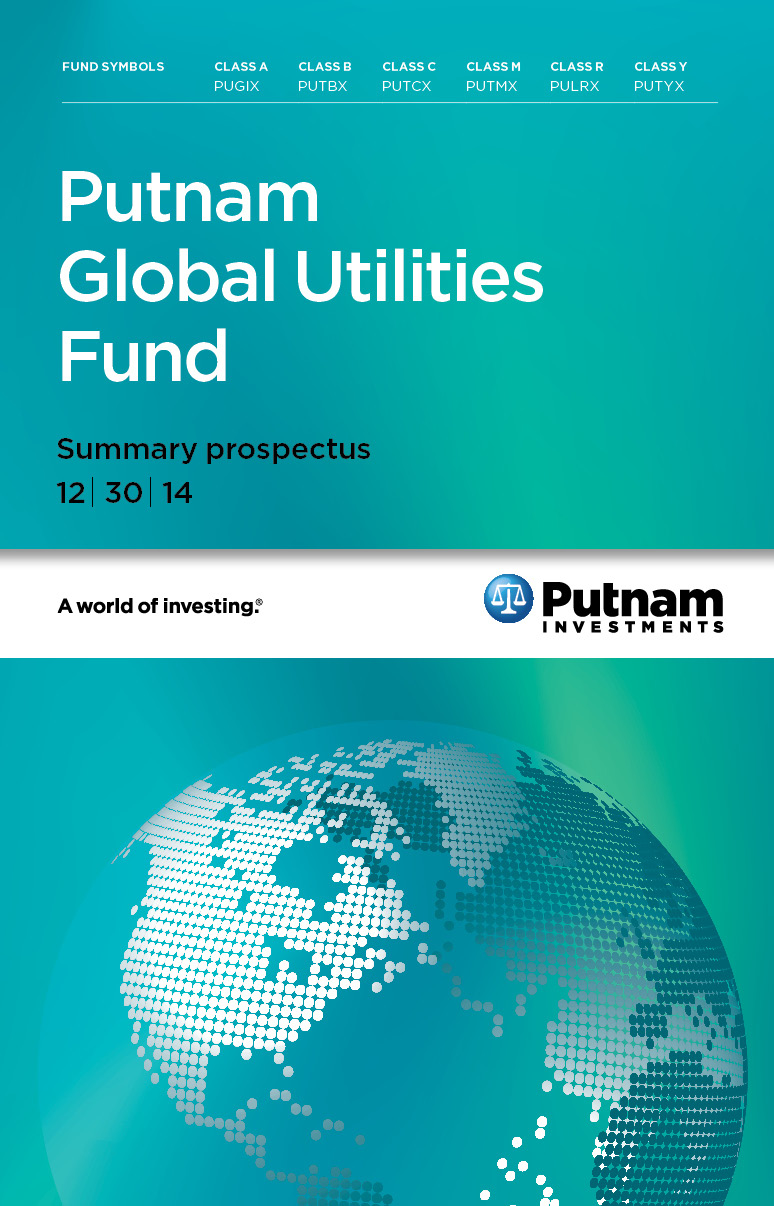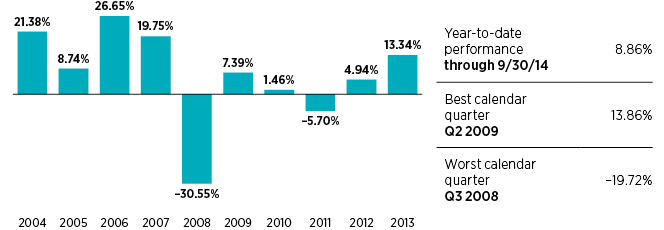
Putnam Global Utilities
Fund
Before
you invest, you may wish to review the fund’s prospectus, which contains more information about the fund and its risks. You
may obtain the prospectus and other information about the fund, including the statement of additional information (SAI) and most
recent reports to shareholders, at no cost by visiting putnam.com/funddocuments, calling 1-800-225-1581, or e-mailing Putnam at
funddocuments@putnam.com.
The fund’s
prospectus and SAI, both dated 12/30/14, are incorporated by reference into this summary prospectus.
Goal
Putnam
Global Utilities Fund seeks capital growth and current income.
Fees and expenses
The
following table describes the fees and expenses you may pay if you buy and hold shares of the fund. You may qualify for sales charge
discounts if you and your family invest, or agree to invest in the future, at least $50,000 in Putnam funds. More information about
these and other discounts is available from your financial advisor and in How do I buy fund shares? beginning on page 57
of the fund’s prospectus and in How to buy shares beginning on page II-1 of the fund’s statement of additional
information (SAI).
Shareholder
fees (fees paid directly from your investment)
| Share class |
Maximum sales charge (load) imposed on purchases (as a percentage of offering price) |
Maximum deferred sales charge (load) (as a percentage of original purchase price or redemption proceeds, whichever is lower) |
| Class A |
5.75% |
1.00%* |
| Class B |
NONE |
5.00%** |
| Class C |
NONE |
1.00%*** |
| Class M |
3.50% |
0.65%* |
| Class R |
NONE |
NONE |
| Class Y |
NONE |
NONE |
2
Annual
fund operating expenses
(expenses you pay each year as a percentage of the value of your investment)
| Share class |
Management fees |
Distribution and service (12b-1) fees |
Other expenses |
Total annual fund operating expenses |
| Class A |
0.62% |
0.25% |
0.34% |
1.21% |
| Class B |
0.62% |
1.00% |
0.34% |
1.96% |
| Class C |
0.62% |
1.00% |
0.34% |
1.96% |
| Class M |
0.62% |
0.75% |
0.34% |
1.71% |
| Class R |
0.62% |
0.50% |
0.34% |
1.46% |
| Class Y |
0.62% |
0.00% |
0.34% |
0.96% |
* Applies
only to certain redemptions of shares bought with no initial sales charge.
** This
charge is phased out over six years.
*** This
charge is eliminated after one year.
Example
The
following hypothetical example is intended to help you compare the cost of investing in the fund with the cost of investing in
other funds. It assumes that you invest $10,000 in the fund for the time periods indicated and then, except as indicated, redeem
all your shares at the end of those periods. It assumes a 5% return on your investment each year and that the fund’s operating
expenses remain the same. Your actual costs may be higher or lower.
| Share class |
1 year |
3 years |
5 years |
10 years |
| Class A |
$691 |
$937 |
$1,202 |
$1,957 |
| Class B |
$699 |
$915 |
$1,257 |
$2,091 |
| Class B (no redemption) |
$199 |
$615 |
$1,057 |
$2,091 |
| Class C |
$299 |
$615 |
$1,057 |
$2,285 |
| Class C (no redemption) |
$199 |
$615 |
$1,057 |
$2,285 |
| Class M |
$518 |
$870 |
$1,246 |
$2,299 |
| Class R |
$149 |
$462 |
$797 |
$1,746 |
| Class Y |
$98 |
$306 |
$531 |
$1,178 |
Portfolio turnover
The
fund pays transaction-related costs, such as commissions, when it buys and sells securities (or “turns over” its portfolio).
A higher turnover rate may indicate higher transaction costs and may result in higher taxes when the fund’s shares are held
in a taxable account. These costs, which are not reflected in annual fund operating expenses or the above example, affect fund
performance. The fund’s turnover rate in the most recent fiscal year was 27%.
3
Investments, risks,
and performance
Investments
For
this non-diversified fund concentrating in the utilities industries, we invest mainly in common stocks (growth or value stocks
or both) of large and midsize companies worldwide that we believe have favorable investment potential. Potential investments include
electric, gas or water utilities and companies that operate as independent producers and/or distributors of power. We may purchase
stocks of companies with stock prices that reflect a value lower than that which we place on the company. We may also consider
other factors that we believe will cause the stock price to rise. We may consider, among other factors, a company’s valuation,
financial strength, growth potential, competitive position in its industry, projected future earnings, cash flows and dividends
when deciding whether to buy or sell investments. We may also use derivatives, such as futures, options, certain foreign currency
transactions, warrants and swap contracts, for both hedging and non-hedging purposes, and may engage in short sales of securities.
Risks
It
is important to understand that you can lose money by investing in the fund.
The
value of stocks in the fund’s portfolio may fall or fail to rise over extended periods of time for a variety of reasons,
including both general financial market conditions and factors related to a specific company or industry. Growth stocks may be
more susceptible to earnings disappointments, and value stocks may fail to rebound. These risks are generally greater for small
and midsize companies. The utilities industries may be affected by increases in fuel costs, technological obsolescence, changes
in regulatory policies and deregulation. Our policy of concentrating on a limited group of industries and the fund’s “non-diversified”
status, which means the fund may invest a greater percentage of its assets in fewer issuers than a “diversified fund,”
can increase the fund’s vulnerability to adverse developments affecting a single industry or issuer, which may result in
greater losses and volatility for the fund. The value of international investments traded in foreign currencies may be adversely
impacted by fluctuations in exchange rates. International investments, particularly investments in emerging markets, may carry
risks associated with potentially less stable economies or governments (such as the risk of seizure by a foreign government, the
imposition of currency or other restrictions, or high levels of inflation or deflation), and may be illiquid.
4
Our
use of derivatives may increase these risks by increasing investment exposure (which may be considered leverage) or, in the case
of many over-the-counter instruments, because of the potential inability to terminate or sell derivatives positions and the potential
failure of the other party to the instrument to meet its obligations. Our use of short selling may result in losses if the securities
appreciate in value.
The
fund may not achieve its goal, and it is not intended to be a complete investment program. An investment in the fund is not insured
or guaranteed by the Federal Deposit Insurance Corporation or any other government agency.
Performance
The
performance information below gives some indication of the risks associated with an investment in the fund by showing the fund’s
performance year to year and over time. The bar chart does not reflect the impact of sales charges. If it did, performance would
be lower. Please remember that past performance is not necessarily an indication of future results. Monthly performance figures
for the fund are available at putnam.com.
Annual
total returns for class A shares before sales charges

5
Average
annual total returns after sales charges
(for periods ending 12/31/13)
| Share class |
1 year |
5 years |
10 years |
| Class A before taxes |
6.82% |
2.87% |
4.82% |
| Class A after taxes on distributions |
6.21% |
2.36% |
4.41% |
| Class A after taxes on distributions and sale of fund shares |
4.33% |
2.36% |
3.98% |
| Class B before taxes |
7.62% |
2.96% |
4.80% |
| Class C before taxes |
11.50% |
3.31% |
4.65% |
| Class M before taxes |
8.84% |
2.83% |
4.54% |
| Class R before taxes |
13.18% |
3.83% |
5.19% |
| Class Y before taxes |
13.73% |
4.36% |
5.66% |
| MSCI World Utilities Index (ND) (no deduction for fees, expenses or taxes other than withholding taxes on reinvested dividends) |
12.61% |
3.13% |
7.03% |
After-tax
returns reflect the historical highest individual federal marginal income tax rates and do not reflect state and local taxes. Actual
after-tax returns depend on an investor’s tax situation and may differ from those shown. After-tax returns are shown for
class A shares only and will vary for other classes. These after-tax returns do not apply if you hold your fund shares through
a 401(k) plan, an IRA, or another tax-advantaged arrangement.
Class
B share performance reflects conversion to class A shares after eight years.
Your fund’s management
Investment
advisor
Putnam
Investment Management, LLC
Portfolio
manager
Sheba
Alexander, Analyst, portfolio manager of the fund since 2012
Purchase and sale of
fund shares
You
can open an account, purchase and/or sell fund shares, or exchange them for shares of another Putnam fund by contacting your financial
advisor or by calling Putnam Investor Services at 1-800-225-1581.
When
opening an account, you must complete and mail a Putnam account application, along with a check made payable to the fund, to: Putnam
Investor Services, P.O. Box 8383, Boston, MA 02266-8383. The minimum initial investment of $500 is currently waived, although Putnam
reserves the right to reject initial investments under $500 at its discretion. There is no minimum for subsequent investments.
6
You
can sell your shares back to the fund or exchange them for shares of another Putnam fund any day the New York Stock Exchange (NYSE)
is open. Shares may be sold or exchanged by mail, by phone, or online at putnam.com. Some restrictions may apply.
Tax information
The
fund’s distributions will be taxed as ordinary income or capital gains unless you hold the shares through a tax-advantaged
arrangement, in which case you will generally be taxed only upon withdrawal of monies from the arrangement.
Financial intermediary
compensation
If
you purchase the fund through a broker/dealer or other financial intermediary (such as a bank or financial advisor), the fund and
its related companies may pay that intermediary for the sale of fund shares and related services. Please bear in mind that these
payments may create a conflict of interest by influencing the broker/dealer or other intermediary to recommend the fund over another
investment. Ask your advisor or visit your advisor’s website for more information.
Additional
information, including current performance, is available at putnam.com/funddocuments, by calling 1-800-225-1581, or by e-mailing
Putnam at funddocuments@putnam.com.
7

%`\5!@@'#_V@`,`P$``A`#$````.-_5?QX```J]TBDB)II
M<6QW=L=RQ75\<[$\P]H=%4.@`"J``````"`$@"L0T0%8@D):3((`!````"@`
M````!4```````D`4F0I*D"(I"DS0`2MI`"``',]+TH``JUDDU=$BL]J7$X[J
MV.X8[B^.=C=5Y5M60(`2```!#UK4)`5``!5%4$J3(4F:Q%8`\5J!0`*`````
M````````5`"H`4%F:))+,@%8BL"(`30HD```YGJ>D`!%9/:)%7)6.>U)YIDJDBM4265FK5$`J`2``:(J@*H``"A4`"0-%60``````````0)`````
M`````````!29HE4D```"A4``YGJ>C`&))JTQ4>:S32>U)YI<3CG4GO252I(J
M(DL%20`0J!6`5*P`&15%$*!48J``50Z!```$``"``0````)```2```D```!1
M-$JD``*%"A0!BH)HDBCE4.K4J!4K(0
M`$A!`A4J5*@@!!`B0:8:8``9#1`D@1(J(`````````````!(D2!,$A"R58``
M*"UFD2))@F"8$B1(!SK4]!4$234DPTUD5FM2::W%J2J3*26I+,55K"MH!T5FKF6KDZ7J]G7-CF9NN;)TRZ7M<7>]?K83-H9&N
M;*X]C7LVA>5O@,NG>1EU;/S0``#IFEW]2V.7CT_8Y=Q&78DZW4Z]H^@X3U/(XG)J7,3M&'H=8T/08#-I\LW_`#O1
M]/N<>Z/EL;?#PWJ>/J5*@;!AWNS\[U&?L9P<1Z?C:E
M3T%R?<;-@W["^+==7K$.3=#R_ICB?1/GKZ[X6#VKL.'>[-S?5YO!O]&T^[AL
MND')]_S&@[G!T_9Y`!W[D>ZV7#T;"V+<];JLGDW0\MZQ\_\`4OG![3\\JD,]
MAW^Q;G!PN75X?U/'$@[]Q_=;)AZ%A;%N>MU63R/H>
M8V'#O>;NUX`D`!00"A1-$Z-@[985/-:S$A(J]JRS656::5FLJ'5:T-,`Y5`J
M```5J"LJE1JPR!``R*HJ,ED)4Q4`0Z*H`A6(=4`!I-(*0I"@%0*R"L@(1P`"
M1`")CFQ(D`*LJ0`*%)-(*"IHB@JU``T?#VR#3#35AQYK+-'FLJLTUK-9"10&
MM#3`,,"!`""!5OVKVNP:'I>>[7&W37ZDD1B;X>6;_F]D>/[J2,N@
M[7#V?!O=:T?2\@W_`#7+=[S>O9.?)-26]:G:[%SO4\_VN-TW3[W.=SS^NY=#
MH&GZ#@76\&2(!Z0X_P!!DC+H&WP-HP=':<'4Q]L/.]S@U0D'5:8EFKS6566:U5DDZM4!6336L@8:`$BL$1F\
M>WB[ZW1-3NX?)J9C'LZ_FT8)K@,NBRM1:SLF'U@ZUU6]E?$0S^+?P.70
MUW-SP#-8]S&6P=$U.]:VPVEL<28)KJ.QR@I966P8=\KDN*VL[8UL4JG7LV@+
M`2(4(TUM`42J=*P=F2U1#$B&0TQDHML^/9D1):&BKS#(JBH!)I5F*55DT0Q6
M`5*`@0##`500(-$R36L02`BH-!H5F*Q-%6`>(:8`*Q),"7K80%`DJ"8`B0JE
M9J`4(XM604%`:;)`%DL@$DR!"SOCUK+HQI1:LP2HD-.P]:LQ4:B&DZ&15``!(@``%2J*HJ.5*55!$BH$"JJ'F*Q`.K4>H`$5@ZH%3V5!6J'
M@0```D"R5("1(1P`D"I6TB"+$B!)9*`BU95E#6S(2;$B0`BU$ZO3I!(J`--9
MD%JNB16I):"*DF&`9%4(LR*HJ@```"HRK%*G*HD5`"HA(J("H]:O"H`.K5!`
ME6#S0J"0````!"@!(E19(DD0`E0182`!'(E291(!1*+`2+`!%J)U>G29#(`'
MFLJ"U')%:CRK,"H``,,`%1E:@@"!`D0:8:(!H-6'F*H`A5#Q4D#UBL1(`#*M
M6"1`'5J@&&````$*``"+42!(`)1K"0!10E':P`"+42!8`42B29UBG1=``2E4
M>8K-6'0R`DL%1`"0$!48J`%450R`($`J.BL0]0.K5`!6(>M2R2!$,$14:(=4
M"!!D-:H5&@L*0K*I6591@`!$QQ8"1(`HE+6H`")$$S':2!!9LLR``%$HD2MF
MNUZ``#3$DU9#35BHZH5D\A4!8!`"!%1BM1(D5K68:2U,5'*Q#UBH(=6@U18U
M(960(""(J..I6!4`27H0($`J4``"1("2ULL2`$BP$6HE"@3),@"R6%$I>P!0
MJ42BP!0UQT``))HPUH95@)%0!I-(````!`@B'A4`0($`XU3@AXBH(%7JK`'5
M9#U"H`XZ&BI4`.K5``\16!*@LS0``"-<``"PE&N$8`"1)*.01KD@)1R85<`H
M)+7XZ`"&)%6"]>E:?<^D7DOLX6-L7GSJ^.\8^@^8Q6K)8"E#)TV/;GF_J7A+
MT_R6H`""(K$`X`@5!JG@X*N5B!4)*@*GM5ZPP14*CCUI08"J'5(/"L```I))
M$@$QK``4*E)E+6I!)$"0D2LEDL65)($LI(!<*"!:VOUW@94)45D6KW;F>L^S
M_P`]_2OS&]G\,OZ9O?'F/K?C3T'S/PYZ3Y5:7QZ_FTL_BW;RN3:,/1^\_P`P
M_6?P+^I?D72MCE[EJ]/3]GF=FYWI^6[W`UG/H/2>NZ'H<]BVN+]'R^.O@VK!
MOQ*;GK].WG'S;Y?-?5/7G!^BZ/MM;J_#?Z1^4/I3Y#[IZ5Y'MM6S<_N?-]9YB['A-PP=#M7.]7\F_%1H50*U'```H(`)HFJ4E20(4D)%@",)DM-!!4JL%+$
M``2+)M^T'SW]*_,;V?PS(TS^_/+_6_#OI/EG9>?Z;
MC>_YSY_>J^.?0'ROV+LFAZ3Y@^R^&_H6^5_L'\W_`-;_`!8'Z(_E'[*^*_T3
M\P<(Z?DONC\T_5WS@]=\5\N=KP/H'E^P>'U&\7]Z^8?L?@_J_B?0V1\N?9_`
MOI[XW[QO.MU_D;[O\V_27R'W3<=?H_+'VGYW%9*@!T2TJ2(JPR"B14&%&0RM
M1X$``DLE`!%J)8!0"4:Q(F5%!):2"61KT`!)4D)%@CLCFP!AVVX%!@M!->Z\
MSUOVR^=_IOR)WOG>*OA\V=?P_D#O_.?K/X;]"<>WO/?/CU?QSZ$>5^Q=@T?1
M?,'V7PW]"WRK]@_F_P#KGXL#]$?R?]E?"3Z7^4.<;G$^V'SO]/>#/3?)O>OE
M_K7$NEY;CF_YKZ#^6^Q_,'V7PCU'Q?>ZMGYGSE]9\3^C7D_MFVZ_2^7GLOS]
M[]\Q]E['S_1_*3VGYUJAQU0(2Q0@#UK($'5J@`"2*$)```%%"1*-<```"-<"
MQ19*M4!;(IN``J5M%%A-2&UED`8AMN*5*A:":]UYGK?L/X+]&?`?ZA^1@`/I
M5X_[?Z5X_M?FYZ_XI]*_'_;N/]'SGRV]I\)_1%\H_8OQ7^A_F;B/2\Q]^?EW
MZW^$/TO\H\%>F^3_`%B\/^@?BS]"_,6JYN?]L/G?ZA^5OMO@
M/J+B^]U?/S?G-ZSXE]&O)_;-LU^E\O?8_G[W[YC[+V'1])\I?9_G1AAE604.
MK5#1#5AAAE6B"!85.K5#E0`!10`C7)$@*BR@BX`A02UJ2"DRD6+"01KT0J:%
M916L`$,7?;!1@"]1'2M/N^]/,_5_F+[+X6`!M>#H_3CQOW/(4S>;NOXM)IX<
M])\L^C_DOM7>N7ZSY;>T^$_0?ROU_P":OL/BFI9^=]$/*?8?-'8\/O6KU/1.]\Z[)SO387+J>4>W\Z]8\+Z'G:;?C?O?+O3_']_ONMUO$
MWH/E#Q#@/%*U50ZK5AHBI4:$D4``9#*L-4($DEDH%$HL```*E;6H5$*%))-B
M2I58D6*E5@0H+:52`4F<9;:```O0`D`4H!0`!(D2``%"H%5&JJ!6#*U`>%:T
M8D014)(AD,-56*U0T))H42*@$E3*L@`JAXK6#Q4`!5ED2I,HL```(M1*64`"
M@DV+%65($H[7`(P([6``2UL=.R``3!:H!(!00```2+```HI4:%8@15#0J`R&
M16#U@5:M6'15`-4\0\U($B$E:5'5$@(H(L%)E)L2`@2
M"-<([``%2J2Y(M1*2J+:Y!;%`19;`"BV-OL@`$P6K4H.5`C`$B!(D2"E"@%"
MH%8/4($50PQ6L!(AHAHJP15D,25K6#H(J$M8=6L'@*O"2*A6(I*L)%1$@0`E
M02!((UP)4A4)42DRLRL@(LEE`LCK:DRE@"1:.P*39","LS2;8^^<0)$%A,-4
MMF8Q[7OOS'UKT5R?9X.^KY&[WSSQOW_F_L?@?2?5G#^@?(SW?YW25``#Z?>,
M^Z:IGT/G1ZSXXZ*UAAH`($,C[G?./U5\G?:?G_B_0\I(CZ&>6^Q^;.KX?AG2
M\C53UEQ?HN%_0_'BL?:_P7ZO^9_JOS_["XGU/ENWYW6,
MW+]3\?Z+\M/6_G+VCP_K7AOO_&7/M%X7]*>58`2H)`D2)*LJ
M:%`%69"S9)4D+(4D2C762R`FRI4)):U!"@38FU
M#/S_``?Z;Y/MV'H>L^%]#^2?N?SU[%X/TCUYP/HOQI]]^;([.NZ'HLG7/Q/H
M^9AFOU0\5]YU//SO#'I/E^VX.AQ;H>8(C+8\W8]#T=C;'QS?\TDT^_GS+]?KC
MX.?1?Q[IV7E=SY_K>0;GE_IIY7[[R3<\WY$[?RW=-;JXFVK]Q/!_L#X6^_\`
MQIJ&;E]RY_L>0;GE-=R3Q=M6AUG2]9,MR'=\K',$Q22)!
M"@)%DLI(6H(4DDWH($BUZ"%)E+2"BI%@Q^7*PJ1!82>KUMPOHGTX\?\`=^G>N^!]&^-_O?S=]?O"_HGKFCZ#$WPJCXI_0_S5]+O(?:
M_1G)]?J^;2WG6Z?)=_S_`,;???G/ZN^)^\[[J]7J.EW>+='S'R"]S^=_O[\S
M_6WQZ]Q^<^&=+R3J_:[Y_P#J#P;Z+Y-Y*[GS5JOHUY;[9MF#I6%L7OWSGU_A
MV_Y3Y?\`KOSW];/%_I/Y(>R_-?N?@?6^2[?F]5S.[OE.MZ?IOCA[;\F>T>']?\`
M1W,]_K^32XYN^5^=/I?@=0%D22+4F"8%TE29$A')5E261A,EK!&*LMA*,%A-
M"PRY9",),+8]7T4\G]G[%I>A^0WN_P`[]_Y7K_K[X3]%!\U_7?%I(GUYPOHW
MA_T7R[Z+^4^Q?#/Z/^8(+4^Q'@?T3PWH^8WO6ZNWX.A\?O=_GC*8\_WU^:?J
M[X]^Z_/')M[S_>^;ZFVG']JOGWZ8_.5]4_&WWQ^;?K'X]>X_.?#>EY(A]L?`
M?I[P9Z+Y-Y'[GS:5'T;\I]LVS!TOG/ZCXE^@;YM^Q_SK_3?Q$17[Q_//V'\D
M/9?FOW/P/KG)=OS6JYN5ZRXWTWY8^L_.'WM^?_M#\]'T7\,NK]TO!_LOY-^M
M_,WU0\G^DOG;Z/X/P;H^&^C7F?O_`#[9X/8M/UFIY>9X.]!\4YIM^=A```C7
M`D61@D32261KA222%B9H)*.;`DVH$R2C+?+E",+)*DLK#V#P?H_TJ\C]M^#?
MTS\GO%L_CW?J?XK[QYWZGD,-DU/7?#^C>7^SX7T-RO7_`!]]Y^>2KZ0>2^S;
MOK]*&8T[9Y_S;];\:*ON5\Z_3OAGT7R_Z4^2^S_/OU'R.UG%]0O'?=/SO?4_
MQ[]Y_FWZL^._N/SKP_I>1K$?9#PGZ3\J]GY]X=]#\KEBGTX\E]WMU?`'I/C?
MZ!OFW['_`#J?3?Q$T5^\GSS]A_)#V7YK]S\#ZYR3;\UJV;E>LN-]-^5_K/SA
M][_G_P"T/SS_`$7\-2*?=+P?[+^3?K?S-]@?&?JCS[T?"8'+SZG`.AX?S=TO
MG_NW@?;/5G)^F^1^S\O^;WIOS^``$:X`22R@+4$NC7!1;"))LH@E[!&N!8LE
M+?+E",+)*EE4OZ9OM_\`.OU)SG;X_A?TORG/XMSZ3^1^U?/3U'R&*:>N^']&
M^6OL_A7W,^;_`*B^5_M/A.L9=+ZN^*^\_)#V_P``]>OA+](_+/<.=Z?[6_/OTM^=/ZG^.OO/\W_5GQU]
MQ^=>'=+R;J^X/._4?HGY;[+\P_7_``C,XMGZA^0^\_'GW/YJY'N^:_0A\T_9
M?QI]Q^7^+;_E/MUX']7_`".]E^:_=/`^NF^7]%\D=CY7ZAY7T
MKB&_X[=M?M?0?SWW7XE^X_'Y(D`1K@`+8LJ)$I8BU)E10*6NHB5M-)E%@+$D
MJ8,N0(Y-)J@I*L,_BW?>_FOK?H+E>PU[-I^2.W\]\?=[YUZ"Y?K^Z\WUGS]]
M3\E[_P`KUOT'\M]T?/?2\M7/WGF>KV[#T/GOZCY)YVZ
MGC_HIY;Z[Z/Y/M/+':\%W;F^J^4?L_@?TO\`(_:_!7I/E/-]OAN25I[B\]]3
M]9\7Z#CK8?%?>^6^6>Q\^EK7Z,^7^W]UY_K/F)ZOX#[CX'UCPUWODGI+F>WT
M?-R,)DTNY<_U_A3O?&/HAYO[OV[1]9\T/3_GSVSQ/KGB+M?(-4S\KZ"^=^Y=
MGTO6\.W?&>!/0?#/3'-^C>N>/]4N8R>#>_\`%?/O1\.`%@1K@`!'M:@AAZU=#JUH=%59*Q)%0DK6H\)*TJAZU:(=#0K"J'5"I,I6(*P`
M4M-9FA"M1(`2CBY(DH%)),JDDEK4B5F5DHMK!&L6$D65-1)F*UC*"*;5@```
M1V$B)*V6Q9+$JL5`"+4`".XJ(`PP1!6&&&&5*Q(,JZ'BM:G5:L2Q6J&K#((>*O$,K6J16I+6M8AXAJU=6I)4ZM4$)*U$!(J)$4$6``2UJ3(
M`BU$K*DJ"I69)1S<`CM9)FA02U@"->.X*+H&P"-8"PD4=(T^[]'_`"OV<`(G
MQOWOG/ESL^#CD0C7`(U@"@@`L)^]OS7]3_(/W/Y^X?T?+5&@5J`2CQ!%9"L5
MEK6J'J:*R(%9*PR&B)*P*R$E*,-%9(.K5!4\5J@)``$1I``5*S8L`$6HE)4D
MJ522CM<*"6LDS05*S-)"462RDRJU"FP"B:HCO8"'<^7ZW[/?/_TK\Q/9_#"!
M%N#]+RV&R:G.=KD6\UWK6[&JYM#8<6YA9;?%#-X]OL>AZ/C.
M_P"=^^/S;]3?&SW?YYX1T?*50Y6H0(J3555=%8AZU8:M98AU:H:M6)8K6#5I
M(/6LB*UB2(94B&@R&5!RM0%D8`!1*+$EDTEB5FRBS),Q@1WN@%%TLI)4JE;!
M*K4DB5FRR-@``DS2TD.Y\KUOV%\+^C/@']0_(P%+A^D3Y/\`M#\\7U'\@ZEG
MYWWC^;?JWY6^S^#_`$(\O]>W[6ZN&OK=YYOJOC)[W\Z3YM^K/E;[/X/\`0CR_U[S?UO&_.WU'R+ZH^-^YQF6IGUW+J?+GV'Q/;\'1
M_0;\Q_5WPZ^A_FGA'2\L55B'5D`"M4JM4.JT0U:M"2M70\5:*LB6IHJZ&I5B
M6*/"L5>H488DB!%:PZH"R%)$V(4M"+!&`)%EDM@LMB)1:@DR6LEE))%J2C"U
MA*%%DF4M+;4%0`"6M27<^7ZW["^#_1GP#^H?D8@5D6_2)\G_`&A^>?Z?^0]+
MV>;]Z?FOZM^5/M/@WT(\O]>\?=WYYX>]#\S^E/D_LVV8.COFMT_+?9\1X.]'
M\OH?H/\`F/ZP^,OO/SUPKI>4($&B&5D`(-$.AZ4,I)]M6"`!292T]TYGK?L)X+]&?`7Z?\`D98$!?\`0-\P_77AST7R
M[E6[P_K-XC[]\5OH/YJ^A'E_KWC[N_//#_H?FGTH\G]FVS!T.-;_`)SWUYGZ
MK\E_:_!_1O+]?]//(?:?A']&_,G".EY9ZU`A(H$D`(.J]:O$.AJPT1(K)6'5
MJH]30EK5HHXU8F5K6KPJ@5DJK`1*JU:@!,K,HE%JE`L25`2+4$L%EDB4M919
M%KT$*+1W(":+)::+(!)M@0H`$=K=(T^[[R\S]7^8GL?A:!`6],\?W/OWS/UO
M@'3\GDJ;'BKT'S/U)QO=\$Z7EO.75\AZZXGT#-X=OQ=Z#YQ]"/,?6?3/(]IY
M([?A.J:?:\`>D^7
ME75:#Q#Q62M61-6M4/%6B):UK$2(>M98J\14%6K#0JB:M:H$``L$5I18`6Q9
M"18$*2I:T2566Q032;16E4TDE@FBR3*K+*A<;=4644``CO8H!"@+H4*)18(U
MD*`O2"2`$6HF.HA63E4/%0*F&F&BK0DBKQ6J'HD5>*M$35JT1(J5B2*O$2Q6
ML1)6LL58(B14H::R1#!%20"P1E)E(L2))91(L2H(4O:)94K8H)6UHIFB02RD
MV$QK"8[*)N=O'1,:R``"3-(D$*`NHB42)H(M01(M'42)*E5@CJ(`$@ZM8@@%
M1U:Q$U:U)%*U2Q$D4:(>*RUBJ'K5HB2(EBE825I+%6JJB14J9#JN%8(DM4FP
M(4$6HDD22;4B201V)-DFRS)*-*S-)E)E9D$F:3(F*;"5E'-KO;Q`DS$L0`*"
M38@I25(LJ8TJL%!%J")6++46$HUP".H@)$!(/6M4`##*R5B2*O%:Q$D1)6KH
M>M9(JQ)6E8/%9HJT0]:R15JPX\4K"J'5D@55*%)5L0H*LJ0!;2JU"@MD;>(*$%KE0`")HD*"+(E$JL%!%J")6++`L
M1:B06"P%B`"H2#15H@`D16M98AHK)6*HFK5U6K$D5=$E:UB)(K)"2*-6'BCU
MB0:*M$!(I6IH5`4I*LEDJRI`%F5FU!`E':U$I-BQ4QS99(FDR61KA24-K430
M2UKS;Q`%O:X%0!018*"+*E$HL%!%E%2E;4D"+4F0CH$DS'96IX$5;>(`BFR6DH#"X.GJ&IV.
MC=+RU"@BRI4C7`(UE%2E;4D0696;)52`LMBR**CA$/$5!%2M8DB,1AW<[FYS
M1$U8:*M%9JU:(D0]:RQ2M8DB'K61$E:21%:PY(H5,JT14FBH+,Q)`*3*18L)
M42DVI)`*3*3,6Q:W@Z&1MCZ
M+TO)Z5J=[K?4\GY5\W]0W#9YEY;!E\NOHFGVMRV^+C*9]TV>5RWF^K@K'=NQ
MX3B7']SV_L>&X?R/;]`VN#Y6X'T_T9VOGG9.GXCFW,]AJ6MT_2?;^99.^B]:
MN/2DRK5B2*O6&BLE8FBA$2#JTI#H=5H/%:0:R-99!1*+4"PF46H(%I$H17O0
M696;+*.;4"4=KK)4HFEIH)-KS?P%;!05:B8SF?*]KYPX?T.YOK^D^WX'@'(]
MM'$JL3%4=GZWC]>KDYCR/:M;%@L/1R5]?UKZSXWX;\3][](>C^8=`VN+YX=KPFGZO8YYH>BWGHWWH^6YKR?8]-Z'F<7BW,KL\?N
M/5\3YF\]]1=7L_3\3S'F>QQ^/8]%]SY=N&QP9(J]8DBLJK5K*AZ0T4DK$RM:
MU<:M2(L5BH`+4DEI$1KT$&DLVI,H`6L@DV2THD6CNHE$EB39+2J431-)
M):UYT-<_T^@:7?[;U_#\AY7M=IV^*HJRE$[+L-_)?:/;'M/A>+U.IXZ\S]9]%=WY]=VP;[O^WMM5ZU>*RUB16M:2DM:M%):Q+%7K5X@"M9"1#TK54`$B4
MF:6E$T(P"U@694)E9F-9)E+!=+*2C6+*)BFRVM&D*22UKSH:X%;$2"+*E``"
M-:,%E2B46!4QI4CKUTL`K8B:)1:,``P^/=R.34HFBT8BX8
MG'MY&^LDHZW(+:8HM2`L"%!5E2`%0.K5`/5)%:C*LB6E71)6LBDE(>*R5B56
M2*M6CU3*-6LE8FK62M:JUB'JJB15PBH$A911%B9H4DDBUB)I8D%FRVF-:.X2
MDV6;))"DRLV6;1I65)FDSD-_762V$25L"+>1O*_:.T=GP?(>-[WI74\=LVWQ
M-TV^+PWC>]\_\3Z'Z]]-\EX'Q/H71.CY7;-W@[GMIO1_*:`D3&`JRI!%G5*@D5$$'J=#(>M7BLT5:(D4EK#5K)6)E7K5XH]8EBL
MD4>J:*24JR*Q5Z@D4DJJK44%EL4594@$=A(7)1BVM'-EF8["919)LMBBS:DR
MBR)22VD3D.AK@EE)%;$2J?/'`^G=)ZGCM=U>UA\.]O'0\QNNWQ=:UNQY`\I]
MGVO9Y?JSU/QWRAY;[#WOT'S7T^VU\'L'UGQF@+**`B]"
MB46$25J%4.J55'@RKQ#UK+%7B)%9JTK5+6DBLM:NI)2&B)JTDB'BLU:/`BLE
M8!U9*PZK"BK4$DLRJP`EE)"PF,6]HUEM*%+2DVB6+%DLVI,HNI'8LS1.4Z6N
ME01V$6(D.$<3Z+CD>F^0;%LXW?
M>X&_]+RFY;7'QNOU/./&]UM^UQN+\CW/LGUGQ/:R%]=".+4B46C31(E11%J1($([72IBJ!#HDB
MM0J9#(EK5XJ\1)%9:5D4>J:*/6LD4DA)%)*Q+7&]$S')$-56(>*UB)%9(/6H
M)::3*"I18D2594EH)F,69CM95J2296;0VL"R6UE2MKH1K4DMF6Z6N2"@D(XL
M1-$HM&`$:P1BKJ1K42D642)2+*F-94B5%(UR`43'-DJ!RJ!5ZI4$!62%8K-%
M7B'BDU:R15JQ+%9:T:(FBLE:M%9JUEI62*3*M0$E:!(H]4L5!4I,K90C7`%M
M*K`6))2.UTFU!+2JT5[4%DMI59)LLS$L229R_4U!8`H0Q-*V!%HTT`1-$H*N
M@BU$QUE4J1Q=4HLB1*B)18@02;*E(`#E8@B)(.BJ!$E(D4D5DK$D5EK1XK+5
M)6CJRTI+$/6LL5EK1ZUGK1X")*U!U9*1(K4H(LDJ6(M1(4$M<`+(Y1K)-Z2C
MN5:*UZ259;%F8TTM:-:DEBV7ZNG20L`1"5L1*I19`%2J5%6C2J56CJ591(LB
MRK1I$QBK+$DB$GII<)$@L(4E;!&NA0H(LHJT::)19*E6225LBRK1@M&42
MBP42BQ5&"U`16(>5:B(D5J/6KQ#J35J\1+6KUI+%9*Q-6C1$JLU*2166*O2L
ML4EK62L.J$E*U1(AZ022UE$`2UJ3(`BU)FDJ$-[*LLRMK(F.\I$TF4M9;(TK
M-EF5F46ZMH_1Z2I(2%(1I("52J:`(D%2B01:D*)0I%E%64$J4%6!4T204$T*
M%8ABH0J,K5#5AD21#1#Q5D25AHAXAXJR)*U9#Q#5K)$-%7@RM1JP#H:L`LR3
M*`"%FQ(*)5*R!9FDRB:6FB5DB:3-)E19FB:2695;W/Y3]!``````````````
M``````````````````````````````````````````````````>SP```````
M````````````````````````````````````````````````````````#HX`
M```````````````````````````````````````&@;FAR?H\W>M+?Z[S^D``
M``````````````````%0```````````````````````````````````````#
MQG[#POFWU/D=.WN3Y&Z&AZ>\?]'^SWSGZ)9Q;PP!Z/.X``'-RW.H````````
M`````````````````````````````````````````````<&[/!\8>\^=^HO+
M^NY'U?/Z+;)X"[W.^C/B?=>P/)^G_#&>R#RL?JQ-Q/8AX7/G`>5#]'QR8A.D
MG>CP.;@?0@^
M/SU'T>/I*````````````````````````````````````````````````0%B
M6XYFC5C9#1#>33C=3#&<,(5,B:0;Z84D`RQJ1LA>````````````````````
M````````````````````````````````````````````````````````````
M`````````````````````````````````````````````````````?&3Z)^5
MZHD14$"`<``=4``$6198(LI&LJT<31,2U$QI2)C66)59$HF-98F-98F-:--$
MK$JE9LE0*ED`PT0T0R)*UDBLM:S122M9:TFK2>M):UFI26M)ZTEI26MLKK="
MYKEFKD:++-$F([41%M?%99=.WR8A*)6UEF8IFEK16LMI29CFRK):8YFDDFT<
MVI:4F53Q_P!-\T965%015#@`#JU0``%$Q++%H8LLS%6R6O'68UD6B3'%HYF*
MMT6CB46B61:*)B72+1IA75*+)64FR5D$6H.JPXU:O$2166M)Z4GKCGBDU,=Q
M6EQ3'<4I<8\=Q3'<4QW&/'/6F66MTM6.:QVQQ36WOBQV;4L,^B
MEH19+629AM9+6CM:*UX[VCM,:T=KQS*VF.;16M',K-EM.[=3C.K*@!6HX`,J
MR````$6B62LQ+JF%=4Q1:B85XXF*92MH9NE95:%=$Q19)M#6ZD#(B56CK*+)
M$A&L`.K(5A)6C1$D4N*UGICFK2:N.XI2YICGICN*8[BE+C'CNJ8I\=*UH[7CM*6F*;
MQVE;3'-HK6CF5FR+;OUN+(I(`*L,"'15`````!"NL6ABRS,5;I:T=9C61:&)
MC6C3$O'6RK0I5:)>.)BBZ)A7B6HF.MDFR5E4HD`!XJXU8D5DK6>*34I/7'-2
MMQ3%.MQ95&`%6&)%`
M```*HJ*D%6B2E;1+HF)=8F%95H5HHM'*.MXUXXE$Q+HM%$QK1Q>):%=4QULB
M5BT2U```'K%8B95XK-6D]:S5QSTI<5QW./'/3'<4I<4QW%,=UBQ7-,>4U]_.
MZ?5NL>:>MY*W6U(9A+4BFMODPV&76QVQH6>36CNAFZS:.\Q6O%>8YO':ZW0+
MQVLLS#:RS:*UEM*+;QUN),K4`58=#J@```.K5"+42$:T:T5;(M$NDVBK*+1+
M11:.9CB8F2.LJM$M&M'%HEHXM&M`NJ8ZWC31:&+4```"2E:DU:R*3UI-6D]<
M=Q2ESCQ7%*3TI/'=8L63P;N:F19K%:LT^UDL&U<4R3TR!%:D=Z0S6*U+3)AM,NMC<^A99=.&UHK72TQ6O%>8K6
MCO=%HK3':Z6F&UEFT=K),I-M[ZW"D`$")!U:H``"J'5`)"-,:P(M$M%6Z)CB
M\\5K):T5KQ3:.TI:Z6F&UDFT=Y2
M;)-M\ZW"<`5"0D4``"J'5`&&`B2BP0KHM!6Z+1Q,:\2RIC6ABT:8JWA65,47
MCFT46C6CBRVDF:6$J6"4FU9A`32)$5H(FE12*T-BA\43TQ7-:7-,5Q2EQ3'<
M8\=UCQW>/#>X9V#3[.7U>A&)1,,7ABR)C7)DR0UU;1&M$M%6RK1I19%J)C
M!8`%9*JHDBCUK.K+2KX8KAA\$28*W%,5Q2EUCQ7>+%>X8S^GU\SJ]&\Q9[BN
M2>F1+8XI1VI%-8+X[7)AL\NMCL^CB]CGPV)DM%-H+7CO*6R1S,5K1VM':T*ME6C3&MM.KV:1;=]#T/->EYC9]7KX'/S[#)K8C
M/SY:6OL>:2D+;$3J7-<DQ%-4M$=JPVQVF3!9Y=?'YM3&9^=9Y<$=[Q6M#>\=K16LDVBO:.UH[6CFT
M=ICFT5KI-N@=C@B!`2#*L@`D4`&&!`@``*+0KJF%:&MT6CBTT=K0VM%D
MO'-HK6CM9+3%:\=K1VE)M#:Z3;H'8X(J%1QU:H"J'5J.`*@````J\*R)AB\-
M;I-HXLEK->'RUCF8UHXM!6ZIZGR_97M-GCO5\AVOC>ZX%V_![)J]CNW#]]HN
MYQH"\ILI%NL/J^SR_37E_JMO"SFN-O@LII#%L=;%BLFCBL
M_)Q^;E5R<:YMP[+'L<8P^Q[[7PVZ<_IW.AL7&G.3UMR[QY;FMW2B(58K52T6
M]\=EEUK/+KX_/J8S/S[/+B2UH+6CR7CM,-K1S=+3'>T,W292UHK7CM;H'8X`
M@&&)%`!D,JY54```!P$!,:T:T*T5;Q+MDALL4E&O$M$M&MLVGV-9SZ/HC@?2
MNWE^6^HO-_48D^?NUX7=]+O><>[X'UQY;ZUF\&_LNOU/'/J?D
MV/M@ZQR_73TS;1I]K7;8LG3/9HP5L..RZ4%\6.G!8VPXW+S;3/PZY_)VN/+R
MO#ZCID>;Z%JUY'E]1W3BVVWETAP8[BMYJV6T0JQS$-J17K9Y,%IEU[#/JXW-
MHX_/JPW0VF.]XK6BO:.;QS,=[16O',I:T5KQVMT#L>?`'&0ZH`ZM42*@```,
M,`HH)B6B72TY%MV.;3@9$$7B6]'^=^I=;Y7L>`]OP.D;7'TG:X^Z:?>O:;/-
MM[@>P?+?7?.?5\EZT\_]'>,G%.KY+5<_.YUN\3FN_P"?C62'7N5Z[9];K=6Y
M7KM_0.QY\`D&59`!(I4=4```88"J*HB6H46W+
M3]7T?F^WXYW_`)I@L_+C7A6C6]P>+^^8O)@Z)H^A\X][YUPSK>*[KQ?>:SGT
M;FN>ZKL<"Z/F,-K]''=/R^6T^UF(S;/@Z&(R:W,=_P`]&O:4R6FGU]PC/GL.
MUZ#X?T"WKDUZ^N]L>$V.9$BWBUG./$1>WMK667G:]F\]7)Y^VIDXM3V4#)=U
M=:T\'6M'%L>GGUYCZCRM.VM1%8;Q'-+:^.SRZ]EFP6.73Q.SH6>7##:T&]DFT5K1VM%:T=[QS,=K1VOT#L^?!AAU:H"J'59#(``J,5`!U*B+3QF]`^;
M^W]4V-(W.+KN?0T[:Y&3P[_J+SGU/TQY_P"E\$['
MAN(=;QUI+UMYGZKY"]!\ZZ_QO<_/_O\`SCT9I=[5]3K=6KGX'WO`=@TN]YI[
MG@\9CV='T.UBL.UF<^G;5R[?K=+TAH^CV3%NY*+Z_;#C;X;*^#$Y-/&H2<6/
MM@U>^'D632B3M[D4KFT]U&BT\1ZHX./T'Q;\VW*WFOH7V/!#:J36VOCM,F&R
MRZ]EFU,7L:.,SZD5K1VM%:T-\D=ICM>&TI:T5KI,Q6M':_0.UY\&&'4J`R&5
M=%4`##``#JU0&6ITO2OE?O70]#TV=KFS%,EPKE\>UI.[P-2VN/PKL^%Z!H^A
M[[Q??QS7C/3\EU'G>F^<'M/A&I[7*]2>8^M>E^-[OY9=CPWH+#T/2O.]5Y"Z
M/E>@8]K3#O&KV?EAZ+Y=)-8HM'%B9JB17+US>L^7[+<:;-BK@+X89I86QX*^
MGC9KC,FG%?6T2V#1+875(ODL77Q>?0Q6QHPY)AM:.UH+72TQ6O#>R6M%-TLBM>.;]`[?GP88=2H#*
MLB14`88`*H9%4!MVKZGUCXW]&;'3+E49K'GV'%MPVP3'ECTOR?OW$^@>?^W\
M_P#'7J?D.6P[^T:W8GKDU9/GGF^MR.YP_9VMU,!SO4^+M[SOHG1]!L]-G>L'
M2V[%M;)CV9DZKDU?$_4\AQ[H><@B]((F6:^FN9ZWJVOU;"^+(UO@YQX"^O/,
M6%\.(MK6$UTS-S^7YN7/&.RC-2)O:7C7RF.->RY(YCK/-GIVC'1]*,3;4V#3
MTBV.TMBLLNO:9=;&YM/$[7/M1=+S'GB+^PN3['Q1[#XE]+/"_H37LVEX
MXZ'G?GMV/%=DU.QKF36YWFT4BWO?B>_[KJ=OGF;1^;'HOF1"&+@#(1/M7E>U
MR-,U#&337"UDM,5LD=D2\
M=[]`[?GP88=2H#*LB14`D`D4`*G4^1].]5>3^[YFV"]G%E(9W%M9FF?&Y=/!
MY^=YM]!\P:N7U;YSZOMNMUL!FYZ&-R:UW3/BUCA96IB;8K.V+#7UKE7C^UQ-5R:FSTRXN=?#HAC/?4M
M6)1.2QL7DF(V'!;2]EONK3N?%Q[_`,[E6F37LLNO99=7%;&AB]G2BM>*TPWR
M0WLDVM[W29BMDCNB7CO?H';\^###JU0#(95U:@2`2*`'4>3],]7^2^]9+)HY
MVFQ>3AS>/-M&#I8S/SV4LLFMI^SQNA:7H9D;-AW\)DU<9DUI8R7U,]K-6C);
MS3S!V_!\@Z'G%KGX+H>@O(OY!['BF1M6WR^UU>1[MT6MJ2UR8B<5O:N%OJVU]7&VPX.<7,MCDVK'+%2+7.//C
M[6OJ3<5F"R"9L[*FZ:C6-AL.OB]+^;1Q&;GYW!T.;=#RGC'UGQ?OG&]]G<^G]CT?
M0_/?L>'T#+I]VT?0>=NEYC4+ZU9![+XON]GKLXV<>N7UEDDTQ$TBFNL9-+%9
M-+E>SPR$ZD$9(8O<4R9"EH$D6NJS;V8K(DA%,XZZW6W32P>JO.\-[QS,-KQVM%>\-I2;1VOO__R\9;
M*:8VV'$7PPS6P5Q-\/+<_)U'9XLBM(/$2Q0+[%F6N>VF7B;NEI:K&]HIC'7F
MTLQUYI2^]:6IZ?X'G+/+J8?;YMAEP0WO%>T%LB6F&UXYF&^2*\QS9+6W[N<$
M)*BQU:H`)%*H=`2`7[8[=Q/JW*>[\PQ&QR.G\SV/T#\%^EM@Q;V'V.3(J\UV
M7#NTOK[%K]'/8.AIFWR,;?!@\VE>X]B@Z%,:\:V4
MQ;F+OCL9C6M;I;!S?5?3_P`Y].\5>E^8;-K]/RIWO`V^/):QEL\>6UKEM*9?
M6/#^@9G%NXRV"UOBQRO*-CD)->:;GG75(FL1N6#K8'+SK.<6;C=P$X,UK9($
MQ+.C&77^.V)R+JE]6SD3#%^QM3MYS%N>&_7?#_`"7Z/Y5])?"?I#=M3N*D+JF7-8]OPGZOX[XA
M]3\EC6@6CK>*)B7B6^NG@/T7U30]'HN;1^;_`%_&>,NSXSO^MU=)[GAO6GG/
MIGC?TOS)8F-9(`BWICSOTO'ZO2HI;6IB[8N"='R6N9=2158FJ*1+Q&8IL;+3
M8PEZXZ^I-K9HB:)MYF\QWJC!YJY_7R:!MRB4BUNMZ+XGG-[U^'A=KEPWR0VF
M&^2*UH;7CF8[7@O:.]D6W[O<&L'@6.K5`-$--60R&'1=9\=;5)B2!+J/,]E]
M!?"?I`MAR],^2BNP8MO<-7L:-NL9+%?!YZR"IUR]["U\I2F#G-T%T5
MLL5Y@M>.;):UO>\=K)-M^[W!:#0+'5J@&BK3%4.ABYRXY;U`M62!+OW"^D>T
M_(?=+B:[KK[^[:W7QU]?7<_,:,FK;/(OZ;%$_.#W'YT]U>1^Y=7>]\]A7B6ABT5;P+>M?/\`TCVEYOZAL^#H2QDP5\7PA];\?U7-
MH;EEP9S=X]G,+%HTQQ(*E5NB<[TF\:'?M\.WRS:XO,MS@)$TB2"1:Z8I5+J,
M="6*W.+:2N9$Y#'9"SLOL=ZFN;$6<9->R9,C6MLM:Q?:];3[_P`WP%MEQP6F
M.^6&TP6NEK1VM;WO'-DM;?N]P6J:1)U:H!ZUK:*CJRWK<9<;@%JR0)>I?-?6
MO7OEOLG1]3M9S'MZ3N<'#9-/#YM"XKDN8R9/%N;9J]AC4-GDJG%Y,#I\C^A^
M8>=NSXCG.[Q<5?%#%XHM#%MHP=3H6EW?1?&]KZ*Y'M,I3/\`&+VWPWCU,WTU
M\U]2YIU_)>3N_P#/DBT:4B<%K[^+P[6V;W)#IG,]/NO*]9SC:XW'M_S"UE(F
M&M[VV&=256:*5B(XM/5K9[
MZ*=2T?+])UO,P7M%?)%:T%K1VO':T%KQ6LMK;[WN"U32)2*`$E:%E42(NL^)
MIAP*VJ]59CWEXK]">L_-_6M+WO-6]L&SZ_7UC/S+VN38L'1V3!T[RF35]GF:
M[ET/%_JOC74>=ZOJG.]5<5R;SJ=J_IL5/F_[7X3Y(]#\WBKDABT"WIKB>_[C
MRO5^B.3[2YKDW?5ZV*KGX+T.!S[>TQY(ZW4CBUW;%.I+%)59*U:(C6EQ[$49LU@M-6U8FQR%1<5OA,U)
M,&SIF>]E:8YG:ZZN%MDQ6//Z0YGSN_C7AO:.U[>]H[7BM>"]HYLMK;[WN"]5
M9$I%`K!XH6,BYR8YC;O`FKEMK8_E?]"_+OU#^>_J#/8>ALN#IYK%N6%\$MU,I3/@\FM'7)RK)@BR8^9[G(\)^I^4X[W%+34N1
M:SM&`V*7^.;"UM>IN92VO@K92U)ZQJL[>YZ_'[AH^)AM:*]X+VCM>*UX;6CM
M9+3OO>X3U5L$2*@T0T5+))K>9\0ARH3#Q'J7S/V'1M[S70]+T/L7S'V.RR:&
M>Q;N^:?>K##9=34-GD8S+IXC+J!R/I^1\V]OYY]9/F_ZPR$9.5;_`)K5=CFX
MJ^&YKEW/5[-8GY,_0/SAW[D>T]R^6^N;?@Z.S8-WD^]PN>;7)@F;19*;.J7Q
M>`_6?)>.=#S=C;&JAU6F'1)-)%5B9IK>3ADB*Q")(FT9][>])49+%.*KGQ.QCLZ9=7R9=QQZ^DWVK-D[]SO![!
M3GQ7O!:\=[0VO%:T5KTLWSO<)Z*W50ZH/6M4%EUEQS7Q@Y4)B2(Z7SO5W5;>
MEN#]/]#\7WW7.;ZK$Y=31MS@8;+IR1DL[8,ICVY3+8MS8<&_8VIK.QS<7?!4
MRV+=U38YN&RZN;P;^\:W6^('T_\`)L$7]W^5^P>D^+[K/X=[8<.[SW:Y.JY]
M.M^R89E)9K0BK:ZMCN
M&,B2MDBY7/DZQ>Q@N\FQY;:;VEUGV
M/D72\ED<6[B_P`.^E-GF6SS.5[G&T';Y?*-[S_GGM>%QF#:L\6;.[6E@]3=FM1D4K*U
MO
MS@TZ=C5HV-^:%E,Z97?I,=XT/#YZNA%-HLEX;6CM>&UTF>@=[@/`L=6J&B&K
M4LNLN.;)C`)`'5J>G?.?6?;7D?N6*V.7:Y-2[KEEB;:^ONVGW-XU>W>8]CD_
M3\AB+Z^#S\\B;F,FYZ?X]C-8]S/X-_$Y=3EV]P-3S\Z-;I>CZ#+8]K
MF.[PT-MP='N?-]-IF?G\XVN=RG;Y>`E8Q?PEZCY16O47"MTQRTR-3/=3JSQCDI>3'OM7;K&6^QKS'-Q2.<[N*?%
M32]IO6&\\S)6(IP1VUL9EU^5WW\1&:&)W7%R.SZGC89M%DO#:\=K0VNDVZ%W
M?/L%DB@/6M8BMU]GP5F`88JAT51]#/!?I[)Q&Q8MW8\>QDZ9=JUNOL^MU,=D
MU^4=/R+UNR9JWL\FO97U]DU^IN>GW-YU>W\%/L'X5GIN>@^)]!]D^8^N[OJ=
MKG&YQ,1?%G,>WTK2[>SX.C8S37\VGI&SS?CU[SX'D:;.>P;^>P]#=M/L^0_0
M?.;R,]DQVUL24NTI;8JEGI],P[EI:6\^]C1[MR=[0-UIN35Z5K9\K1Q[=P6]ZX7)CQZ+2+O$V:_H+
M1\%?->.UX;6CM:&UXYMT/N^?8K:'5(25H2FRUNLN$`%RZ>&S:&P:_4D1MNKV.AZ7?):;L\C1]OB8'-
MH\VW?/?/+VGP?T'Q/H7H3B?0.HZ'I>J:'HTB<+EULQBVF3S?;Y'B+T7S;7,N
MMLN'?Y)O<7@73\UC;8T@)]O>3^P&]H[7AFR6MT+N^?:#(=5HAE0
MN]C%+>@`Y495CU'YG[%[!\I]MV_!OXK8Y6+V.5C[ZN$S<_-8>AEL>QEL6YL6
M'?GC):331=WS]Q6^;P]#F&_YK&7PT6^8'O?SC;UR6C-:QD@9/N1\O_6G(M_S
M^NYM/=M7J7],_P`]_4_*<3DQ_2WQ_P!CO\6]\6^L:CF
MT.53IWI+?G3M62,,L3+CZ,U+W6
M/(1GBMG:+34BXK6:E?.74T+JD;Y@S<*WM5(O"E945JI/-'K3ONGX.*UXKVAM
M:*;I:>A=[S[U/%60R&5K*\VL+(J@)`0Z*GTT^:_KVPS\U;ZVS/$
M[[I]_)8]B\IL;FL/1^T/S?]0^%O2_*^FZ7?Z_S_2=,U.SB[X5[W$^
M)WT+\[_3?Q/W3FFWRN3[O!\Q][P?:.3ZXK?%7P\NS\BN;4KFTV5EI5DS4QRQ
M3(+S<:,=K17O#-DFW0^]YZ2AE60RK(ER5GV*,AHJ
M$@*N5/4'F/LG<./[[,TS9_'GZ[H>CR^/.DM2V>1I6UQ,+ETV-BP[^;P=#&Y=
M/:M;L;%K]3/8]SGNYP?EG[W\X6\7^EWA_P!"^._1_,?$GI?EO4-#TGU-\-]_
M^(OTG\P?5;PWWSTIQO;WU?0X)
MU_'@0$3Z77IDUES\^55ZU>(EK2:*Y;G>OFK$],U[CZ-)UI&*?'M7-.A+7?=S
M[G'CFK+UNRSPB7M[Y=8S4YOEY>M9,-[BQXZ\XV^:[,==;L,,TL)ONN'B],Q>
M:CO>&UHIO',]$[OGI*F59%2JMUGQR9:R1414=`B0#U[Y'[MW?B?1.D:7H9;Z
MEEGYF.RZ"(6:6%]>:,F:Q;FYZGZ7D-#V^.JVWZW7\.>I^/[)K
M]7T5Q?>]1TN_\5_I'Y@]U>6^M>VO,_5-@Q[7#.CYCE6]Q=BP[G4=+N?#SZ-^
M;YZY\ECV?H?X[[1\Y/9?%],V>:``*M5?Z/=FP[=GTO)5A-6DT4EK7*Z?H[K%
MM7>/:R>OWWB+#:\$MN9G-/Z)+7:>-"XQY9:Y:QM$YAD6;M6N,G6XGNZ.LWU8
MZ8KJM,;DVK2UJRMYQQ3KM.*X:_8]3Q\5[PVO%:R+=%[?G7&59`.K>;6)K5>*
MA4=4)!CZ??,/V?;WT]>W//K?6O&+.8]C:L'4OZY>O)]'OXC8L6UNNOTNBZG8S--K"9=#2=KB3
MQDDBW-M_S%A;%>4VNU\KVV8Q[>.MAM;4S^'>U+8YW"^GY3'7Q=9T/1:_DUM$
MV>9MV#H]IYWH_AI](_-.F9]&-,:TL97C)96Q(4`J/4%4933ZTM+66UR*S@FK
MCGBC1$E:Y[3]'DL70L[\>RR^:DK22*W%,O0>9]SJK)6STUJQ62JC)'-B(CFT
M638\S[W!UF=2%$ZV7C:[CJV\[;NOAK56=3JMN=AL'.V^O*M[6CM:.;=)[7G:
MDB@,B?)CGSTD4`)`)%0D.^>?^I>G?,?9]IP;VU8.E9Y^3@-KB7",;DTI(OX?GOJ>4^5'MOAD:\:T:8UD6HD(P`DJ`1(K(KFM'N[ARO8S5R6.SQ;;+S-
M=W_'R4KLFEZC+X.QJF]\WEK#Q7,8.WT7F?88;:-O//:N.XQ[4L9'C*-BLYN;
M9]'7,F$II.TQV
MMTKL>=)2*!(K/GQSY*,J%1P)%7A5#S7Z!_._UG%?6BOIY%.=Q[.5K;9<6UO>
MGW[:^OF<.]+&3G>]YWG&YP]=S:76N9ZVTOAT';X^7Q;G>>5["ZB^!R:UE:DI
MQW>\_P"%O2_,_+':\1&LBT:46C6$J*`T&!#JR16J)*6R.'^R^#I<]ZGRAZPT5RN'H]%Y_U&>FS8WY-Q3/>8]N]KU;ENJC&.;Q?:
MY7-=G%A;8I:5M&/V+S_3\VV,&`MK\[S:?H/5CR%O:]9P=#B^/MR=VP^6MYO'
M:R6MTKK^IW
MMWUNI/.#7=GC\YW_`#%C:D,TZMS?7:;L\K'6PYNFYZ2XOO-!VN/J&QSL+DUL
MYCV^(]'S&M9=7INGW.#]/RWC?O\`@.0[W!C65,:561:B8P*CPK,-$5B)%*DM
M(>*R5I-%=JT?3]+Y/T#BGH/B4](JK8^CSY5B$=,_*=C0Z;BV^%[&GV"M/
M.^77[YA\+;S>.UH[6Z7V/.--60\15%WM8I;8R)K$O:M8/6KE9B1C(CLG$^F]
M%YWK=0WO+^J_+?<]?V>%E*;&43DHB.VNT9=AQ;W4N?Z;:M?I:#M\;EN_YW)X
MMNXC)PSI^5L+4]'IXI)6LL1MFEZ/>>?ZSDO8^52UJT1<1C:CK/,^H;EJ^KNHOD:;^O9?/
M6C3EIEFILW#86+Z-FT_/&_HV5JQUB&*=GU=KJNOMQS.KY-6SM?6\FQ;7U^<9
M>?+-.-Y<'<\7A&FL,W2]NE]?SCQ6L0Y65[N:[U`TPUJM6'B'0\TK%:K>A?,_
M:=4W/.;II^BZ9S?97",ICS[?@ZG4-'T>T8MJ:::9M<76,_.WS4[O">KXO74R]%U.UUW0]#\._I/YBX!U/*PQ:-=$HLB8U@"-<&156H
M%8B6*LK)0R&I6=2M6SZO:VS4[_.>C\_>L2162*R5CN/(^M75;SURYK%UM?R^
M?6)R./?R>/JY>O3JMJ>32X%N<6SM;0LFG=UCI>"_8=;?FGHQSEQEM#6[Z/'M
MKG#'KV34YO>_3L?B\C.M!:\=K=,ZOG)%`D*WK?;.&L`>:U1)%7&FCQ1HO<4S
M=*Y'O1;IW-]IUSD^]SV+?RM-B.V#4]SSFVZ_4QF;1T_9Y&,RZ>U8.CTG2]!L
M>#I7=AYWSQU_&^./0?..3;W!C7B62+1)19%E2`*LRH``25K
M(JT0U4L4:L2JM6)*T>(EBC52Q66*/2.\\GZTU66Q[NRX>[9VTKJNQD*;]BU(
MU8BS:UM.'GN7!YCZ&G[BY?H6;4!8VP6-M+#VYGF#=KZ%UXMIZ.J6><=OS^ZU
M\AGG/AM>*UNF]7S;JL,->M]L80$2*NJPR)6*2F6YQ[%S38N*9_7GC/TYYE]3
M\`](>;^V3F&V./;WQ9"FSL^OTMSUNOE:YO+OH/F/COTGR:&+_3OPWZ,\T=KP
MWGOK^)Z9H>D[IRO9\_V^1XZ]#\SBFT2ZICB\:43$N`````/6LBK(:IXB6*O6
MC0>*R5J\5EK5H2Q26*M6/67G_NV9Q]&:L[-A[6A[7DL?;5LFO=X]ZXKGGC8M
MII?QO-%L/=.P\CS\+@^UR;Z-S+-W(UKOV+I9^N?7LO(P&7G\SRX]+OX[;8Y,
M-KQ6MT[J^:9#E1[TO=C$#JNJR&1+&.?'FN<>S_-V;#W,??2P=^:UG]7S520$2WI=[&.JKHD5(35I&_5S*V634U#=\W:7P['K];PI[7\YV\Y(HM`R1K1+PK0LD*O$,AAHB:M6BCUAZI(JT5DK1ZG1+6DB"([I
MR_H&[ZW>O:9]HP]?=]?T5G..QG6I&37[\NW55>Q4U#+J_.CL^)O9_GJ%>%>)>):)>)>%9$]SX_NR,GG_`+/ADM9*VC%65,:P```R&5X\UYBW;BN6YIL7%,\M;R
M1>WMAQ^36L,NIN?.]SR[L?-_5?C?TWE,6ZDXLIBW].W?.^//8?`(5X%T6B7B
M6A7B2BT24FT:R3:.ME2B:$:X`%4.@0PT5K!RJ)J5:*/6K$D0U*R*R1!5/6C1
M5T=%T_0_1GRWZ%^7_K/S#Z!YOT/I.IZ7:,/6QEM;$6U]AP]3/8^LT9=#S8/`
MG6\/C+8;=CQ-M77[ZM9RYBF_D8S6,QCICUAI[WG7'!>
M\-K=0ZOFF*JU1--;S8PLB6(O<>:]Q;MQ3/WP<#L<>TMCP&SR>#=_Y9"R1+1+1KPK1K[5J]OU1Y7[)SGH
M>F>1]#\J=?Y9Z\XGUOKVCZ[H&OZ#<,':(231X232
M]V<3Q6_QY[W'MW&/8N\>Q=4S31=EE1:6PX[+J8G/SK#)@AF;9?:-+UO6N%]7
ML:/3?(WC)U/D>XO*[',^AY?3M[BV
ML%E2;)4%$T2R!`5'01#P=6L)(AXJT5K6)!ZTDK#15AH34QUB'16(DK#Q4J:$
MD5V?#TO?_G/T!YQMJQ65L&)OH8>^E/&2\KN[=CZ.
M,9+&:-,8*^GC9;>UK6OF-L\7^FFB]MDUN9=?P7&^Y\UC6B6S.
MOV,CAZ/4>1[CS[Z3Y=83ABFR)[GYWZCE,/2DQY_,_K/CA:8Z`)DB`!K&J%6J
M9$BI"2M9$%:M"9#5JU:O$5@Z):4(B1!$25B2*E51ZQ(K]8?(?JCY:^J_+_5.
M;]AUEUN99^=`C6,FGC;8,'DY^)M@R]-W)UW,]CZ6KVPY6,F%MCQ63F1K-FX&
MT:_,ST:%O?)#>_3NGYID2Q6M:R(RNS3*8MZYQ;5S7+=X]B>+.LT3%-;.V+'Y
M-/#Y]#'WUH[6MYO&O$M"OVGS7W&TOKX':XVK[G"LKZV$S\[?N7[7:=+TOGWT
MOR%)11=+VCK.:P=:;'L9K4['.>KXZ2P@5J$E335HAZGBC!2LA)
M%7B*UJ\14>(EK0K$B/7O%^E<)WO'\_V>#6@'J[=H^M^F7F/T/\9/9?D>#2^R
M\FSX\?;3U>\0JVZ^5C)A+80R]"^3IW
M3\U)%'K5R:*YW)L9''NW%<]YCS35R25EXLDQ;VI89=7%Y='$Y=.WM2&]H5X5
MXUHE]]X_TF^Q=*_P].]Q;VQ:?H,/GYEA?7TWH>9Y)W?G")C66UHXF.;)6T43
M672N']"NL&[+BVN0^H^4-)I$01!!H/$/-:U/%7B*E:5F*UI)$$5D@#Q$M:$1
M)$?9+Q'Z<\%^@^/^9^IX!J0#0R^/8Z+K=SD^UYCD^#Z]L5-B6NQ*B9C6:XLTU,LL2\6""U;.^#&Y]'$Y=+'Y->%>&]HUHUH5XUH9O',PKHM
M)3;1U+H>:Q.72L,VJB4F\9'6\N/8Z7POH?/^WX>-%_K]'`]
M#SS5R5K"3B`)*Q):I4\*Q22#1#5B0K6CQ`K)4$D5DK4B-OP='[Q_/OUS\*??
M?D?3,W)>L$`DK%LS9'2^AW6'UMS&2J->OI\0WO$])UO43K>311ESN/=Z?B^=Q7O;VO!?)T_H>8=$D1+%)(KFHWMAQ=>>
MF66+R+5+><=CEUK+)K8[+J8S)J06BW9$O,*R+0KQ+13:.;0KHM"OTK@?4E6N
M\/0N\.]"VN0LVC6CK+TR;AS/7ZAU_(0S4`SG(]:4M@^OXX')5"
MJL'0T5:#Q5ZF&K1HK5#U!+%?N5\^_5GR:]A^=N0[OF/5O'^A^5.M\Z:$D5*B
MJIZ[XGV+S=F[.L7P-:&;1+Q39$Q+PKQIC7S6EZ+:^9[.XQ;O+/2?+K3)K*F&+
MT%@]E!5J`-CM6"6QN2*U052#*M2&0R'K6L6DK04>JL`EBOMWSWU+R!VOFN'O
MIU5:#5-6&B"!#ZC>7_0?E?>XGAK>K6<>SX]S$7YO-MK@RJ.B%=U6C)UW3]?A
M;XM:R\S5"]^G;WFI(K-%)8JZ)JY-ZP^JFKD:)"
MUOAQV;4Q^33L,N#'Y=..5NR):8EDFT"\:T*Z6F%=%H5XTQK0KS4V\OI>AV3F
M>NYUZ+YK:Y-=")<*0K(*"+$05BLJP=#JD*PD0T5K5(J$E*U2]:D4DJ#I&KV]
M6R\S$6TQ#5,J1$E15)%0*O:WG/T9RW/AYKFU?.G1\#V#2]IQC=\;@;X+9DN6
M.T96)V/?];TUG&QK6;CXG)S;:1CCQWO#:T-K].WO-RQCEBLT5(
M/$;QA]5>UVGK:"^.QR:^.S:=E?!C\NI9Y-6&;P,B$=KQS:->!:)=+3$M&M"O
M&LBT*R6FM<_1_*_8N;>H^2VV77C3&L$F/9GP;MIM\E:YJ3`Q/):F@RK(*G)%
M:Q#UBJ&B&K%4/6*Q5ZF1]S_GWZL^?OH_C_#M_P`G]=?&?HOX;>]_*#((AXBM
M35AD!Q[%[?TAS/H?ECJ?/[=?LVE[#@V[YF):.+03>D2TPL*1GR<3B+8J)$9)
M7N^OX)YQQS>*]H+7Z?O>9GK2>*5JJ.KL^+O;!B[-)65\%AEU+&^M8Y,./S:$
M%J6]LD*R+):T,VC7A72;13*)@7C7C6C6BF4FU)F-;--:*UX5HUDFT,RJT
M"\:T:T2R3,S7%?7AK:/8Y\N;4FG
M!25S;!)6K@-6&B*H>E0IUS5]!Y]Z'C(UKMA$VS)BVSMN/>CF4M:.UH;6ZIM^8FK6L16((BA<5R[[A]C%>N/R:
M=CEU;.^/'9=.UR:UO>\2R)BF\-*+VZU+2BQ)%H@!=$R<
M;VD>360BP[,&?12V&W6M*VCR:D$1;Q?>]_@.5J!Z5J2*%`2(*UDJ[!H>EY7N
M>=M;8V1)0*$-_P!7L?0#SOV'YO>E^(86^JR&K7&QM<\KZ#`5WO3?-]]YQZ'B
ML9;#$M$O0MV2AE:;V/396P4G'*K*K:1L]HP>*S<:44RMK1VM#-NK;7EY(J5"
MH35RRUMG8[63;^.SZEC?6L\F/'YN?;VK!.2*4:T:\=I2;PKQICM9$Q+Q+1K1
MK0S:EI18$6C*)%HTIR?5Q9,$=;6>/83)K132R8\=69[XYIHL"6\[O%:*M$-6
M`DBA4PT16*O5^A_YC^R?B;[W\N<5Z'EV@]0J(W_4['U6\C^@_E!Z[\\Z;FY0
M50]:\NIZA-7VNAYN?!;'=4VL6`M6U9((OF8U>\X/"4
M$F4M9+6C3U?:\O6L""$E;W%.TK,K%B2+1E$BR1>PX_L+16&<=K$P9=*[SZD]\-
MICRPUO=6Q05OA\6YTKH^<:*R14JJAXJ52!%:Q#U5@ZH9.F?*8\VN9-`1]"?-
M?9?>/G?K]E?!\%O?_D(`>*^D^7[J31^D^`^]\LVW'L^C>7[WR+V/G446EFB+
M8^,]$W\X,#&](]4*WP(+0N19EN29@_-2$^>[R<7L"2TY'3T21AL_RJ\T'Y#IAM1K/D69
M;DF8/ZFT^:'#(),]K9[N1T]$D8;/\K9ATPC\P0K>?(LRW),P?U-I\S,TAS\@
M;\R_!5)W$.D#1J.D"2$IV\NWS4G<$HT!)T'2!(T"4[>11;B'2"DZA2=PZ8V<
MNWS4G<$HT!)T"4[1TP2=#XJ+<0Z0-O4;!L&SEV^:D[@2=`2=!MU/;YI3I\&9
MZ#>-XWC>-XWC>-XWC>-XWC>-XWC>-XWC>-XWC>-XWC>-XWC>-XWC>-XWC>-X
MWC>-XWC>-XWC>-XWC>-XWC>-XWC>-XWC>-XWC>-XWC>-XWC>-XWC>-XWC>-X
MWC>-XWC>-XWC>-XW@E:__(NZO8GURAZY0*@]>7^*R?H0GF6(Z
M=J5?,U*>"HZDA"S0;:]Y34&9)B+,+BJ2&G3;"5;BG?-MTT%Z58^05*,T^F6#
M+017=Y?X!)^A"MI^N2#G$'GC=.$UH)WU0/D)_P`H/U.?+BKYQD;4B0G:J'])
MGH#E((%*08?TW1#_`"3OG!3J8G)\X:=5"D1WND?JT!][JG!^I?F03+280O>2OFS](E_7"^E2=ILNDLEND@.KZAP
M_HG?.!PGB#\Q.$+ZO\`=1O2B&I)\BT$LEPC((A*,.Q-2C1C;,/0]3*&LPRWT
MTG"4$)VD'XIK5';Z9/QNH#AK"()AV&9FPWTRDQS=.,P;7"2R;HC,&V8DLFZ(
M\OA.K/='\T\'I1H4PYU
M"X27C:$=\W#,]!ZTN*W%:QSU3+5H<0]1*5H3"S-1GH/5EQ6X>K!ZI_#I#_5-
MB*;@*(@+A),%#/4BT$[Z8?U\%/I2$R$GQG?.`%.D@)D)5Q,]`$KZX?T\)HA?.4V9F.@H1T[4N_
M5'^F7]4,2_E&^J2V9F.BH,)VI<^;'TOO;`236#C*"%F@T+WE)<#;!K"HRB$4
MC_!9PA?4))Z)ZRAUE"$HU%.^F']U,=OJ*X3&MAP5B=\X;>\P9:AU&PXRM
MR5K)(]6@=="^+OU1OIX2OKA_3PFB%\W/EQ=^J/\`3+^J&)?TQOJ7\N+GS8^E
MU6XV-$EO(2=-8BA)+13,C8$NDK\&F)U2RO8H&6HZ9":6BH/RG?3#^N<7E"/1
M7"<8@EYSOG`/C)/5<<]C9F;AI@D#@D#!!WZHWT\)9:*A'Y<)I^<(@OY<7?JC
M_3+^J&)?TQOJ7\N+GS8^E1:!,=ZIPBT*=],/ZW6^H7F@VYA*"I:2#CAN'&:Z93OFVX;9HE)4
M'9A$"(UFXWHVTO8:5DH/2"1P2'?JC?3PEM;B:<-LTRTF%RTD%*WG';V)7YD$
MR4F$*WD[]4?Z9?U0Q+^F-]2_,@4A(0K<3GS8^F2WH;#^T=9(7*#:]Y+D[32^
MDP\Z6C1:J_!5))07!!PU@H2C#<,D\)#1NDQ%-M0>CDX%0U$$PU&&8I-\),N4/7*$9XW?'=5^:/\`3_AA2&F2:'53Q-U)`CU!N$02HE!3Z4A#I+XFK:/4H!*W!WZH_T_P"%
MR?I9^KE;^0?^J+]$SZD.'IZ58^0BN]0GG>F2UFLTQ%&/S,&M6XX_T_X7)^GD
M3\@W\@_]47Z)GU04>0G)T.#\YJO.$WKP6C>2BVG&^G_"Y/TL_5RM_(/_`%1?
MHF?5!^D3Q!^41$N8D@8B_1,^J#](GB
M#\YK>I,N](TR4F'Y9<(WT_X6\C>E$-23Y'X_5!Q%!J%H'(AJ-E&Q+\4W#CM&
MV0DL&Z(TD6&8>T+AJ4;2-A?_`!(K62`F0E7X"2R/\??_`%.DVX'W
M.D2#U*,\;H1*4H)F&/5*2K2U*'JCW>H4@+=)!==80Z2R]0I8;
M=-0;-6YYXT!:M"0_JGJK,)/7\:6M"CD,I03YFIMMTB3!$$?_`.TX3A)^B+]#
M!Z+9U>""T=46KIEJ"7T1&1L2[\H2RTDGN5)+5;Y:IBK+:H][CC)+-AP]6U$E
MR6LMKR3)!$LR0UHB(LMI+)08/\\P.N%M8(C0:%-$VO>7XRXPEP%#204DE$F(
MD@TR30:9)H=$MSK).AUDG0M&\FT;"0R2#.(DPF,E)]$MRU;2/_["@Y\H[).)
M;CDV%LDHPN(E0;:)L.1DK#;)-AM!+6F(D@9:CT:0E))"XJ5!#1-A<9*S-HC(
MHJ2"62(O2)!%I_Z/[O/F4>G^+//+2.IHCO`OUG?D'/
MIB*VI)1/&TLB<_Q"6DS2I2D(;W(#+AK!_4'=Z35O?#K.]*7'$".R:0[\@OY1
MF_R^E0$1]5_XIISJ3K_[T_7)'KDCUR1ZY(]N2/7)'KDCUR1ZY(]N2/
M7)'KDCUJ1ZY(]N2/7)'K4CUJ1ZU(]:D>M2/6I'K4CUJ1ZU(]:D>M2/6I'
MK4CUJ1ZU(]:D>M2/6I'K4CUJ1ZU(]:D>L2/6)'K$CUB1ZQ(]8D>L2/5I'JTC
MU:1ZLAZHAZHAZHAZHAZDAZDAZDAZDAZ@AZ@AZ@AZ@AZ@AUR'7(=A<#D=3?\`CT6*.J$.:@R$F"2P9:?XW$9Z
MJGE".SU@<1"5/Q>F4=>]-@SM/_&JL3$Z$1=)QX_^9_\`,MC\JK!.J/\`&JU>
MARV%.`HKJC>_6?CN&J/'62K(_P`O^--.=,VW"<)XU:*BNJ./O!GH)3_55_C;
M$@V3:G(6.ND+EH0)$LW?_=)Z1`](@>D0/2('I$#TB!Z1`](@>D0/2('I$#TB
M!Z1`](@>D0/2('I$#TB!Z1`]*@>D0/2H'I4#TJ!Z5`]*@>E0/2H'I4#TJ!Z5
M`]*@>E0/2H'I4#TJ!Z5`]*@>E0/2H'I4#TJ!Z9`]*@>F0/3('ID#TR!Z9`],
M@>F2/3)'IDCTR1Z9(].D>G2/3I'ITCH)'02.@D=%(Z)#I$.D0-HAL(;"&TAM
M&TAL(;"&PAL(=,ATB'2(=(ATB'2(=$AT4CHI'12.@D=!(Z"1T$CH)'ITCTZ1
MZ=(].D>G2/3I_P`#,'X)?XP?^0F#_P`@,'X1?XL8/PB_Q8P?AE_BI@_#+\:T
M&@VC:-!ISZ#:-HVC:-/",'X9`OQ70;1I\+M&T&7,8,'X9?B6@T\0G",^J0)X
MU!:]H]00ZI#>7%*MPW$->4R!H!IXF#!^&0+\/T&GA&XHS"M0K4@V9F#;U-;!
M)X$&VM1T2,.N:!#I$1N!1^82C4%S&6H-(,&#\,@7X;MYW)!("923!GH&U*<,
M.$9D44PLE!QPT!,;RZ)-A:]QD1J#;02TD+3N(RTY]0E05Y`N51`R!@_$+\*T
MYTN$H:AY*$!ITD!U_J!MLD$XXLPE]8<>Z9%+X&A85N&H:;VDZC<7IS'340U,
M::>!N"#Y3!EJ%-@R\0OPC0$9G2$1DI"M=#C*"?^
M)*C5JAS8/5@I9!+Y*/BZ]L!R->&@\QY\GER$?(9#4T@OSAUKPR_"''2;'7Z@
M01$7(\\LS2G833Y-@IB0A>\GG#4#5T$QUJ6#E^;JR23!DK@1I,&TE0.,D-LD
MCB?D-Q&"0E04RD&9'R:&",^&O'R">92=!J6FI)"FR5X!<"_!79.HUU"6]P99
MZ0?D],,R-X;?)P)=)1A2"4)"$(&J0\Z3@C)(BDNF@B>6D-I)E)KZQMJ)!2'M
M2:;VA:E:FYL)ATUF%'H-_!*MH6>H-!!PMH\N7S&HU!&-?`>9TX)61A2=O@%^
M!FHDAR0:AN(P:2!MF"=4@=0./[P;I&49*4B2\K4I"B!O[@44MJ&B<-"";(2G
MC29NJ,)T07J2,>2C4X1DR6@=,P2S(?(>9<#,&8,>0VZA1Z'KRZ@:+42G303"3(*+4C9+13!`V!T3!),$9D"<,@V9J!Z@P9^>H^9N`]1J-
M>70:`N;4>7%YO>"3O"$A7GS$"_`%.[0I6X=74>1CIZCIF.HI(Z@88(@KY*:\
M^D8C-J6FG51A,A1&RZI9[@MXDA"R6/($'S\U*,
M=4R"2\RUU(_/7S(P6@(?^=1KRZ#:-/`(N#JM@^H+:)04G0&6G*7Q[CW#>"VF
M"1N!M&0(S2">,@V\204X@^^2RZ!Z[#T)Y1#K^?52#V:*:+6,E+8E&I:M5)"E
MF$_E(I>@6KJ&G1)%H/(?^"4>I+#3AF9$9`E!)@C!!9>:2!&",:\2T!$"^0,N
M74:^>I`DZ#;J$$:1\PI)*+;KRE\<\L&8ZA@U$8-!`VC'F@R>,AU1^0PU&Z@-
M@R!QU$9.*'J#,=8E&A2`E*=.EHGI&DMBFQ"(]9*R:$5PW03!!#&TU'J#T'3U
M$C\I$M1$R6H5_P`8:7N"3T!'H$GH$@@KYZ^9*!'Q\@6FI$-O*>O#4QO+0M`1
M<"!H)1F@C-;6X&G;Q+XUXS222T#CF@U28Z9&.BH:&D=4QUM1^4-L$\;B>FB)
M&-)S'S(S?7HM_<2EI49DA9DR2U%'-1FPK52E+'J5F#;ZA>KV!7Y0CYF@B&XM
M260E*,C4XK1O4R6WJ-_3"5ZD2M`DPD.%YGJ-1NT,C!&"X::C9S:`B,&8-1`]
M%#0AH/,:\7&]XTT!`@7Q?TAM)K/:%0B,=(>G5P)]1#K$#4@P;1:QDI03SNU)
M.*2:7U)-+^@):2+1&U;1))QC82FE-%!:,N'3+@F$DC,M02=`9:CHJ49ZF;CA
MK-QTU&0V$8V@B,AYC=R.MZ\"^*06X;"UX.
MKZ9*>49]4=1)@D)4"8)9]!6FBFQ7HT+ID'UI2%J1HZE!!QC:;C!H"T*;*"V:
M2YYNNY>Y!$\I*6%FLC3Y,LDDS+4)B>?,^KS-6H4%`]`1^0($0+B?)KH>[S29
M&-"4";T&TQYCJ<=GI%-<,U&M2"3)4E+Z9,RC0&%D2DF3BW5)6K3
M:#4$J(O!=:W!;6T&GR;+R($6H(AISZ@EZF2B,;241HWC;YD2AN,BW>9*(^&G
M%2=P+X8N>4P;A^G5H:#2#,R'J#,^N2E-J09H:1H4;5/IE:);/1LS2&Y"DGZC
M1&39$9-:%L5H:E$74T,GBY//BM/QLLS6I*]#3*4D
M%)\C4G:XVD*8_,I@R4MLTFLS"GE:')/;':);;K+;)--(,FHV\)8-1K;,E.ZI
M$'Z.1R6E!S=%$48]K#1F&D&HU&9FIU0]2K2.X:RXK,(/AO&X*&WR(@7$^8PH
MM0IHC"FP:3UU,C2L]2=(RW$#;(:<=W$RT^$+GDN]-*7U)'6\MS:ST;6:(^I>
MF5HDE)"=4AMY38;D^:7DJ4@DOK(MHDEO6[&-L*;4@D;DAIPTJ-XU&N;[I+#&FWBL(X:`TC:-`0
MU&H,^?34;/+9Y;5::JT-WR-XAO(&@C(T>>T>8U&H,N"R^*EOF@-HZB'FFT#:
MG:J-H2XJD!Q)H"EF%.JT=D;R<>2:5FC:MA*4QF";#Y[D(;-8,S6;CR]5RE:(
M?V(C+0D,H2M3B4J4RUTBFMFLB841-$>IK,S=?4L+?/8T\241EI(T$E2G23N)
M26BUUXK""X;09:<",$8U!@^?0)3H$$9!"CU0YJ:7B,$9.$M)*'3\R;T'F1:^
M:5;N&S3BHM/@BYUL$LW)"6Q++JJ]*K4B-82L]42E)-J1^9I:34RA"S:8)P_3
MFI3D=1&Z1I"C-*6Y"FTQW^F:7B4IUQ*SE$A(6P24-15+)J.;G&:^:0W+4@-/
M:*<=)9R5H4%H02&624F.UN5TCU=;-!QTFE/!9!!`^!F-P(P7`QIX&IZ[]#-W
M0^H1'Y$9)(C4G<-A[5&HAO\`/K%H-!IQ46OQ3K2E*3JD)<-`*4HB.1^5U:22
MZVA).QMA+B*22F30E!F@,N&V:7C-3LCJ')<0%$WM:91M8C]4S:4:GVS;-6J4
M-.FV&Y"DGZU8D2>H.HC9&).C+1.&\WHJ0R;8Z*DH:(PCYK69FI]1@I)D3#IJ
MX*"3&@48,$"+@9<=1J-1KPU!KT"EZ!1D%D1A39`V_/0R,)<,=8M-2'RX>?(H
MO@"\":YM(G322I*C);R7%?D<6ADG%%%-:BC*,R2:C4HU!U]1A6OD8V$8V#S(;C&O%1?$.R-ZDK2M3:$*!1OR^
MD5H;1I(C-)-NFV&92D!EXB-LTN+VH<4\RDE2(_22<924M(,Q]7`RU#ZTL$PI
M!FM25JDI20..1(:BFH%'49NIVFK4B;=4@F'U;E()06T2QZ=.B(J4CT8(&K0$
M>O#70:\5\",;@I0W>1`@8,AIQ,@:=02?).NB%'H1`G2,D*W!2"4.F6I-C3AJ
M->0_&+P%N$@NFG:J.:2<8-`6DT!1F'7C4'9.\G'DF3FQ*5,I)"8OY&F%+"$&
MLW%&HW%JT1)4A,=_:&YQJ4)4?JA,`]$0U&:VE$;R#0$F:4,J-)]=0?D]41M'
M$)92P&YI+-23]47Y!03R*/0)4#,*T&GD1#:#(&-1KP,$$F$K"7""7
M-01$$H(@8>(Q^;7<->97C%X$U)J"FS29ZJ'6/Y#Z34T:'%(;)]1,]5:X
MRB-]OIFLC027%()F6:`U(T4^]U52EH,NB@D18^X^5Y\W0N5JF.ZE"6=AJ?3X93IJ4B4I)HD:!*D$E*4$CTWY?2J))LJ
M(D:D&U[#;D*W/2.JX+B]-$>-U1T%"0C:9I4E,/ZP\^9GZH]([QKX.1]P4QY-,[`I>@2K7G<
M&[R2H;@HP?`N7:-GF:3U/4C-6A[_`#)6HT(R-.H).@V\Q^(7@O[&@K9M=;))
M.QS2;C1H-Q)I"U&%2#V^IT0AQ*4,DWI&9)Q2F^HMZ(:#<9-LD:D$:ZKD*4<9
M>Y,AWIDP:=QSRU^8D(W);C&LQ/\`FG<1,GHI4A2C9/JI2@D\'5)4HV"6EACI
M\JD:A"=.=:AN\D:#R"B!I&@+CH-`849A2M`:]`:N'3()3M&T]-#X%RJ\0O!E
M-FM2F#(]IF:5GN3)41IDF:NH3RW5(<6^TDC>C;`N*I"4MGHWY&I1J-U]2@4L
MR1$<)`)2%*.6EL2]JTQXV\%'49H3M*P,-+-!]0]9#YK!2=$1WDI,U(,TIVA2
MR0$.DL>G40;1L+F=#7,M&HZ82@:!00%`C&O(9Z`U:`P9!2=1H-XW>9'YDL;A
MJ->0R^%WGJATT&W)-`;>21-&@B:929,QNH&XJE&2#,W%;C=4H%)4E+,K83"D
MK4ZM*U26T$"B?DCQC49MF1O(-`29I0TLT&;ZC#\DS#,DD)C[34Z:%*7%):4P
M0F&H^$XA$(]W@.+T#:M?`,:CY\=H,'PUX'YA1`T@R\CUTW:`ST^$+PGMK1?D
MVK:3M=C["=8-LE(-):F1-NFV34I2`V_^=UU+BI.P+92E$:-N)$=2S=;Z9N)4
M@FEF@D+,C=?-PW)&J([R$AK8M4HD[EQ2VLQ36.@H(3M+D(M/!6C<$(V@CUYG
M%:!"]1LY3+0'Q,&#&HW#<-1MU(TZC:-H,AJ"Y#\(O"E-&X'&30'$[35J%N&8
M=DFH.2=Q+6C8A*-C,"$ZCIC
MI`B,B\]-X2O4&H:#7D5X1>'UC-1/GN)XE*(T.+4A*UO-:J>C&@.-F@B(R0TL
MT&A9D;LDUFY*W)9=028Z$N*=0E2GXNP)BGM0T:S=(]R]22RX;83(40D2#-41
M>Y/P)((@;9&%-ZA*-H)6O!T@W\^*CT!*"@HAH-.30(_*-WGN&X$K4:A)A8_\
MH+X:4Z9".LU%*6#-.
MTFT[4Q]2;CFL);-1K^:S,)>4E+,HT#K?FE.I49]/9&:0H$SJI^*:#].I*(Z3
M4HQ%^CX=:-P0UIS.*\R<\D*!GJ:]!IY$0TXD>@-P=0*5H-X6K7E(PHP0+PB\
M1UGJ`E$V)*#,W&M@4DR+S(D.&@,O&1]\9#0M$(U&T++0&7D"&HUXH^:_ES(&@T!<#\`O
M!UY'?FGR)UP]5OFH+=_*2D[&$)#3!+-;!DIYDVQ"09%PD/F:HCF\B;(@N*E1
MRB00B(27X"Z6AF6A(X*5YFL$KR3S&?!):CICIC8#0"/3AN&H+P2\7:0]1YKC
M[C>;+5YC0.,FE/3/1GR/E>B]0VFNF7"4G14-!D7X`M>I]7R0YH$&6J]#-9$-
MGD207'7@:0:07Y3W#<"4%*&HW#R&@('X!>,3)ZA9>:]0ITS+KF267]H9,MW@
MR'S0([YJ/X]3.H=21!+?DA!ZFG0*+0?^"5H"4"4->!?,^97#:-.!&#\`N;7P
M%>1-N'KM(..$HWS286VG:F/JEAHS/P7V.H&&-GX"]\_/1L]#ZAAQSS4O4B,M
M$D02G4(3J:F]0I&H4C4&D&D:>>T;=!M'3'R"2"@0/P"Y3/P=-0B/M,&R>KC>
MPW$Z#4](Q_F_"75;2)PR!IU#RB2&C(((C-:?-Q&@-&A$",-_-1F%*,@:M`:A
MJ-1N&\;QN&H(PH@1`_`+Q2XJ!&%N'JZ\9A3I&F+IX#JMI$Z9!Q\]6E[R^.46
MH3&T,2&S,$R>C9&9A1C>>G4\DK#)^?C'X!>*7)T2U7M,WD%JMC:49O3E,]!Z
M@]4GJ%)W!,8.1]3;1TR_!-I!:R4:FB4%H(B:0#1J9MD8-L;!IP,AH-@VC:-H
MT&@T!_"%S&@R-:=#7\HI\BUD@(<)P>F,$6G))^;:S2"<,OP0FSU(M`MK<;:3
M2>JM=QZFOSW#7@9@E#?Y;QO&\%Y\"!_%N.&9N.[@APDDV]N!.D8-1$)"=0PG
MSY5MDL=(B),?3@9Z#77XIV22#0YOY7CT2V?F$ND8)9&-W/K\67@+8U-<<&P9
M$EH^#GS-9Z1U'X4CYH5H"69?$NM'K'1M+D,M0EHD\$%H$MD0)H@E&A],$GDV
M>1IU&WS)/D?'37Q->8O&T#B]3<41DSH02Z2AN+F,]!UC&A+&PB!,$7`ST&NO
MPJST(U&9H/4N9WY))1$WN(FU*,D+,^"5[N12MHWCJ#>"/7X30:>.M@]5M&0)
MH]&_F8:^7)IJ/3@N1\,_!J>49LJW)'I4\[KNU2WR(*>(B-9:$HM"/7Q=?P-U
M6TFW#U4O4TGJ7A'YC33X,XA&9)V^"^X1F24F%IW!:-Q&T1DELD\^PQL!%IR'
M^!J+4)9T!H+5):?&K=)`)6[PRB@F=%+2HS(.;@7.I6@WA)Z_A.@3\N12MH0Y
MNX&>@U^$?^J']+RMJ2?41^`8;>W\>J1G\0?Q;CID?6\D.[@3I`U$06G<3:/,
M._,M=$^1_!&@C#TK:;2NLE,1)<#61>`1:<2;(CYR;!%I\`?$OB'&MPZ/DAK0
M=,PX7GYZ(/0;C"U@G/)!CJ`U`C!'K\`[%-1LM],N"@R6B?`7YAE!IYS/0:\J
MO'+XQ:QU/)"]!Y!>@VEHE.HVA2=!H"\5;R4;
M0:`O+X(P7QJ_F"X&/,%J""@?R+0%XY@CUXS`@-_5R2"+;'))<%!LBW>&?/\`
M_]H`"`$#``$%`?\`XKDI-9K@.(!1U&90UF;4!QTB:-1JKW$FB,M8*$XI;5ZA+S*F5''424P'5)3`=4EEA3YR(RXY\8
M\5<@+AN-AIHWC1&6M1U[I*D1EQS]`[OY%U[K:7F5,J-A1)3`=4E,!U28\-<@
M/,*9/BQ%7("X:T!IHW31&6M1P'24[%6R?I%D?P456UQ^2WU%J0T<>:WN)!/-
M+E;Y$XD)3)E]1;=J1NPUMFVE:7D-.H$9)QW+!+91A"NBZVC1!:,R7?^-*$.E&
M(I!R]$J_!6G.DHSU!3#(-R#2/5F1J>,TO.]4^0W3VLO&T;C^\ENFLCFZFN0:
MR>=ZI\6G.DI1Z@IID&GS;4R\;0]4/4'R]8]C#YLF[(WDMXUD^\;QG,4%/&I/
M%ISI*4>H*:9!N5M+U`*28]2KEZQ[&7C9-Q_>2WC62732DG32EQTW/@R+4=`Q
MT#'0,=`QT#'0,=`QT#'0,=`QT#'0,=`QT#'0,=`QT#'0,=`QT#'0,=`QT#'0
M,=`QT#'0,=`QT#'IS'IS'IS'IS'IS'IS'IS'IS'IS'IS'IS'IS'IS'IS'IS'
MIS'IS'IS'IC'IS'IC'I5#TQCTQCTQCTQCTQCTYCTYCTQCTQCTQCTYCTYCTYC
MTYCTYCTYCTYCTYCTYCTYCTYCTYCTYCTYCTYCTYCTYCTYCTYCTYA3)I_^1>$P
M3[GV\T/MYH*QYL2:%;8,M.9M&\_MU?\`BM5^M(0_I1OKXM_3:/F\Z*QXWFKTM'DI-9HIGU!=,^D5N[I7:
M='\<^C(7S2D8XZ9IOGC;:&..F99&7_%_@%5^LZYTT_<+05D+8E7CCW#'OTLC
M^8QPO/(?THWU\6_IF_JBF_0O_P!:KA%&1.O>DHLA<$&5ZI%Y^MCOT9)PQL9'
M]`QOYY%^E_@%5^M-_2Y,=>\K*!ZQ)4KXKH7I$Y#^DRK:H.4SR3?8-A3?TS?U
M13?H7WZS+G53/@KCKCPG)!Q(_IT7GZV._1DG#&QD?T#&_GD7Z7^`0GR8OFD")<[5VEHB6@0;PDI7=LI$Z1ZAQ%^T12'.HL0+A$=NSE
ME*776QQ0F\9,I.0)(1+U+:+&44ERJLT1$VU@F9PJ;%,,6MHB6D5,],,[6U1+
M1_[9&VS<./CVH32,D%T+2A+HUL\*%!+:2IK(T$@Z!E+KEQ$;0P
MTCJ*^V5\8T)HT7#9-O\`X:1;A6UY1$V%NF*%7;YAB^=0'+MOIK6:SQ_]6[_1
MX-5[KH#E:\WQ0@UA%6\L.5KS?&%^E:_K<*;]"_P#UN&-#
M(_HAQUK4/0NA;9MFA4K1\U&K'/TLE^<8W".0J1MA1EK6/0.AQLVS;7*T?-9J
M#$1;X.ED$'&U-GP:JWG0Y4OMC33\%HV.H[.D>G;4>[EQ_P#5N_T2+45M2F.4
MBQ:8#%HT\W(%O7
M$\D0OTK7];A3?H7_`.MPQL9']%+,;;;'NK(MG4NO0?TK?]?'/TLE^>.?JWWZ
M%',;;:'NK`N'DO/0/TKC]>GJ_5FZ\W#2B_84D*E!+>]$T/1-"]92VK'_U;O]&C9ZCMG*],V9Z\*66;Z,A9
MT/'OHNY9LH"%FV<1_KHM6NF\TPIXRI7C!5S\W1,1%F+BG'R1"A'EMR!=52=OX(E1I.OG%+385"9(72/I-FB=6(,,HB
M+]PE.8_^K=_HPI/IE_E?3)HW&S9I77#BQDQ4VLSU+F/?1*C)DI>J'6SATBUF
MM9,IBRMTF8SUFW6%-'!JUR##OU0OTK7];A13.DJ9$3*2[1O(-BA=6;+*6$VL
MOU+C"MJP[2O)5(CG'5!_2M_U\<_2R7YXY^K??H1U;5AVC>2J3'..J!^EZMFX2&?P5IY31Q\A";MDPY?-
M)$J[<='S%7,3$78VZ)+8A62XH:O6EAR\92)UNN3PJ[)$1,VWZBF+Y"@Y>,I$
MZS7+X0[W:7O3(FWAN%]P-!9ZG'O&VT37R?,J#E\RD3KA:%K`3$/QH;9=.S+1[_"ZG]:0YTT?<+H^X71]P.B;/5+'HG09:
M<$Q'%!:#0:(RW"6TIL-5SKH?AN,<6VSD_1R!\]1C[IJ3D)?EH&MJ+Z4:>##YL*;7U$VGZW^%U/ZT
MW]+EE?6*_P#2N/UZ3]'(/U1CHR#Z*-6K.0)_Y.$-.QNT_6_PNI_6F_IF1-NS=*/=MMHF/$\Y_\2+$9;YN5;S9?@"V%(+\>KB,XWK)405L4IKCZ
M.FNVKTPQ(IFF0[1I!U#;J*F`F6&:AI8*J;9%E7>D#,2/MG5I-)C5)2&3@,DY
M-C>FW)..WU%RJPDO*@1DFZ@D*_&6(S[
M2:R<\^JO0EN5*B.*>R,9&#_Z..#'!4?KW/Z]@6Z/--$`/JWQ&EFB$E6TU,%.
M.UD=9V)^I?,*-52@V6JI>QBM<)+URRHG6TFQ%C35,MV$5OIRF5.Q:5E74@NI
M5(6IE"GYA+?NF%$XY'6V5BG6-0%H(45?6LU+3)3):FJFQ_3N?C,6R6
M3;RFU.7CKA3;!4P3;!4P>X*Z4*>J((4]401WS85)D'(4_/4\AN[=23MHXZCU
MZNDPUUE(UK61%_4LYZXKLJRW&;_Q#'_U9OZM?6JE''Q(LS)G_%"='V\Z/MYT?;SH^WG1]O.C[>='V^Z/M
M]T?;[H^WW1]ONC[?='L#H]@='L#H]@='L+H]A='L+H]A<'L+@]A<'L+@]A<'
ML3@]B<'L3@]B<'L3@]A<'L3@]B<'L+@]A<'L+@]A='L#H]@='L#H]@='V^Z/
MM]T?;[H^WG1]O.C[>='VZZ/MUT?;KH^W'1]N.C[;='VVZ/MMT?;;H^VG1]M.
MC[:='VT\/MIX?;3P^VG1]M.C[:='VV\/MMT?;;H^VW1]MNC[;='VVZ/MMT?;
MCH^W'1]N.C[<='VZZ/MUT?;KH^W71]NNC[=='V\Z/MYT?;SH^WG1]ON_^P%Q
M]+0]P;#2W
ML>D(-,`O/_&G$=0G630;"$ZHE-))]+82D1V>F7^-O,$Z3D)21Z=01%4H,12;
M_P#=)[W('O<@>]R![W('O<@>]R![W('O<@>]R![W('O<@>^2![Y('OD@>^2!
M[Y('O<@>]R![W('O<@>]OCWI\>]/CWI\>]/CWE\>\OCWE\>\OCWE\>\/CWA\
M>\/CWA\>\/CW=\>[O#W=X>[/#W9X>[/#W9X>[/#W5X>ZO#W5X>ZO#W5X>ZO#
MW5X>ZO#W9X>[/#W9X>[O#W=\>[OCWA\>\/CWE\>\OCWE\>]/CWI\>]R![W(!
M7<@%[OCW=X>[OCW=\>\/CWA\'Y`][D#WN0/>Y`][D#WN0
M/>GQ[T^/>GQ[T^/>7Q[R^/>7Q[R^/>7Q[P^/>'Q[P^/>'Q[P_P#X&0+GT!@R
M_P`83S&7`R!D%%_BI\$`O`,&#_Q9`(%SF#"B_P`60"\$P8,O\3/@@)\(PHO\
M50$@O!,&#_&=1J-1J-1KX&HU&X:C7PDA(+PC"B_%=1J-?A=1J->8@D%X)@P9
M?B6HU\1452$E$687!0V3+!O'[>L'$60-A1<7&S;,VC(S;,N;7E2"\$P8,@K\
M/U&OA)C-H2&MNK1(44A*4!$@TH9L#<,R"O(2)F@]#EH9*]:N2&(_22I26RDR]#=EN&3+G34A1K(R!D1`S(AKMX>84@/,
M$9,)2LI"$EP;0:SV]1*T;#06X=(?(%X1@P9?A6O.Y$6TDTF107I$@Y<-4@H5
M><<29)R#C166R=KV=(T+U)JIS2""7F-&S9UVB9)-U41XF5>XH,'*:69)(@2B
M41D?#S"@>@5H%&1#HDDYB#X(0:@RM1"2?FR8(:#9X)\#"OPE;2DERQ*0UB+6
ME$-FQ)2YLXY9I=4DBLG2-^T<>)DTDI-JT8>5ZMQM#>U^.4@CI_)=0H.05MIX
MPX9/$FM-!ZGKKY'IJ1I'EH9#S'YB!FH*!I2'6O-#AMA"MW!3"3"2,N!#34&G
M3G,&#!@_P:)7+DCVPXA27%K5R0(#*$N.G(7+@*DDJB<(2&#CJ@QD,DALI[MF
MRTP2:8R3#CJ>5/0IHR\PHG$!,MQL%9N$4B<6J
MJB)D*7"9=*2\J:XACT#A@]H)"2!H(PMO4;#T\]#$@MQ1U[BY33J#3I
MRF#!@_P-B.IXXE2ADB94@)=403*0HUPVGR5'$:O..IN(M+EJX\Z=3!;V*JV5
M!-?TR5;J-Z1,5%1(>5)5H*B`AQ*(C2#<-3ZO:E)+\[:68JT+GK-8A(29*80X
M-24?DHR(C-)!):!)&0(STZIH)I.Y!I,:'KYZ&9C4&X-"&B!TTA1:C0QJH:^`
MI'(?`P?X%7P_4J;CI2GH#>MLO4$02M+Q>C0#94%7ZD.1['K)N;!2R#;RF@=@
MZ:*^;Z13\E8U&O.I(,N!@P85\?!K-#(@4)>..$*ZM5'<*P22>NWN7`:6#@$2#B.$$$_N;EKVVSKD
M@JA#;#1-M.AN.@S=T>6=.2@PV<=MTU.K,E&9ZZEJ:EM))*V/RRXJ4)4I)A:"
M,.)U):?)1'I'61)=5H%((R4WJ-OF1'KHK12E:*49&K7<2CU:<(*2E8T(QIYE
MJ-?`,M08,&#"OCJR(2`1`XB0E"TAN0L)FH,_R/I<@(690S(_^=LIEMZ12+%"
M@BT94E<1HS*N0@O0J:2^T\0<==ZA2S4YZQ#BS?:DG?+02:MA4P6T9,0U6*S#
M\\W4MH-(02AZ@TG6_P#*M;+:CGJV&SK+.7')LUI(PM&X+3J%ZZ+UT9T-&Q*D
MK:(R6C4&D]?/4MQ!9JVK<-)&]H:W"09F1&2$D"1H7GX.@4G4&7`PKXVK:0XM
MU6X1HFX&VZD>K6A/KVR!&ETCA-FKT!D6CI'*LE02C.E*D75LAQ-%6H4A%92@WV$*FK8;79(:0B>T2666V2*L9;),HXZ_9SD$UJX;Y:)2^HP3:
MR2I@Q4-I6AN,V:Y9DA<>3L,F3EAYDD+4C4+3J%D8BJ+:@DF1-ITZ)&E:/)2#
M"B4#UUZAI-+^I$HS3U-2-:5$HB,=/0R+0%X2T;@9:`P8/XM#9N',<3%23JB)
MG(EI'K3))6;(\M5UK:PJ"H@EM]*D35DBX=>D*@P^J\Y%;<2]7MNIVMD7HU(/20A/JE*=8M$.DB8VM'20VI%:AI)0#9;<:=C-O+?81.L#C%*M
MFXY+L664K5N/F;:4X#+;P8/0S>-P2&NDTU9N)2JH5H1Z`E&0)PQU3!O`WA#T
M-*&20$-;`TV:";2HB)\TCKZEYZZGJ:]#-PDFVL@I!)4E!),P1^(ZC4&%E\21
M:B2KH))]1)X0XWJ5M0&T(.$6OIG$$N0ZR:[)3"3LFDK-34N"VZY8,H94EW\\VT*61!S0PAI.O2+4:Z#7D
MU\!YO0*^.JHBI#A0MHT?027W$*19H,(LFE(V):-NM0RA['&5)DXR0L#?,K&Y
M]&L[QHU/63;9N&AM+L=F.UX,6"B.F#`1&)-?U`^P32S;(S?01>`S)4R(1K63
M:5$:#5N]1M4^O>I1GJM6T.*T)2RT/11;"61-^6AA.X%Y\NO`N!#7B9:AU&T'
M\;3*>U0X\2DV.U"+!`62'P_%;DA58A;C4-1.P/4;8\MTFV++_CM)WK7,?BI0
MTAEJ0IRI;<JU:!2]"-9&1'N"2+1*"((;VA"32$&K4E<=1\AJ
M->)#4&",:AU&\EEI\;3V*8R2M&MR'VW22A"C35H;2JM4VW)9?0E^8_O7;[7/
M=V^H[*;W2T(=*56,N)*L)II$5<1FN8>92]$D68:KG736@VSY&)"F#]T=WQY\
MB:J;)?;*5/4RC8ZT31'I4G^6Z4DU\C1!TN,%XFQZE)G,604H*7H#40+S"4D$
MH(@E.ADDR,S,E*<-)FK3CJ-PUX:#3D/R&O"6U\;0H1'9<8)Q+U,RZ2JG5;;+
MW5C2GM&K%1-M6*%-L2DO(92@PW!:W)JD$[:S7&),&=)G*F37D+FVIQR>L4,H
MCRD+;AFAP9`9&]R1J9U]-$2FEKLT=6?,0@29"&T-H)"6HC1D56WNLHR6%<6D
MZAQ/#I`D:AOR!K\U*T"OE\PE)!"=`E.AGKJLS(UN;0ITB&NO#4:C7AH#3P(]
M1H-!H-01@RU#B-A_%5,,I;KM:TZ$P/\`DZ%;HDAN2U(>ZK5MU'(]RR^(SR9!-,(U9A
M-$J%5DPN)`=2Y';DFZQ9//.V]BN4*Y),OOR4,!"$QTQ8#!I9IVR7(KCD2+5A
MYPIK[D=N.XXTU-F'+70R4,J58-*5,4DD(92A,.`VP&*]/6EPENO6;+BTOK<9
M:B*7TUM.3%*2:>+82-1N/53F@6YH%GJ7U`FRT0UL!%
MIP,@:0:1IH?TC<-PW`_,$6@/S!$"\^#[73/X$^>/9N1VXE4[**D64-HKEGIK
M<2P'8S9HD4S+J)E89MRX[J&Y\B1'3,L%Q6RM4LMQK-E:(2T/$VAMYR55-2G+
M.O.2EV"XTU#BNQT5#CSI,6*W7Y=LVRN;9(BEPHH"71*IFWCE0=S4:*IE%8R\
MV([SZGI9&-1(;WE\3"G---.['0]%
M0^%4S2G&ZL^M#8>4]!DONJAVQR%,7;+JF[!M]V0E#YSXJ92'H"4M0JPHB*F*
M_HTJ4;TN>]U;&S](E,MM+=?+3*2V:'GYL-$L2*UMQ!43)%6U1Q0<9\W[1;VZ
M=+5&1"D&IFMG%(/UK:WI:D![3:RPE"&H+:356)-=A#2T00060U"2!:@S,*,:
MA*M0DR,S(M7&R,*9(R:;_*RTI`02R5O,E*5M,_+AH-!H-!H-!L&T)&H7Y!"M
M!J-0^WL/QS\#'8I.K<@MNK;J&FU1X#L9LS?B,29SD1E=PF.TY;,H2IU#2&V4
MMB#6LH#-,A#IU[BY-@U)<NW"LD2UNN-N.2D)6A->R0AU#
M3)>SJ-ZRBO.G/==9:B&XENKL52S.X23LNQ:9!NI(HFS8F(T;DFN;>5-A]9*(
MQMH:FN1PW8J2J7-.1P(]`:M>!+"5:@U:!1EH1:AOY=,MSC!&;[6I;%;8^_1E
MQ6OJ-%K>))J,@9`T:C:-H47DD*!#0:`P9#0)(:<)2-Q?#P:LXS3L9YAJ5(?:
M"K4R=*[9-Q$UMYQ:4.JDPT21.IFI`L(*EHEH>BL$X_$:@3WEMU=IZQQ-NRZ[
M-?0@O)L@VX;9UT=RP78M/(0PT[':J77EDFR4;TRV2T%V;24Q'.HAHD+5)BMO
MKGP&S;;?6V&9:V3]P]'H9ZA#9K!IV\"+4&6G%H&1:N)\NB099T!,
MF2GR40>W;6W3-,>01A$I)J6XDE/I+1QLC+I^24^2==$F"4",@KS+4$6H-/'8
M"3H-!M&@<1L/Q3\"-&5)4:G/+?>N")^;9-,')DICIBM):1%C,FI^I9D.V==U"DXZAIL5%EZ(W,C3N
M>O&4ICS6G$0GD/DZE+C\YI+J/;VM*^L**+,U17US7;`Y%(II#-6XZE2=I\:S
M3IVNFH0%\C:-YNM^24*(H^X=11+??VAB>C9
M*T:,PA8)>HVDH$0V#0)!GIRZC4P6HEH\8_`QY]#08E)>0DDM$J`CI/5*>C(K
MG$-34OQFI$I=YJM@JAMTL=]"
MBL)"W[>T-I'+"@(B%'J"0[8Q''G)I/H:BD^RV\V]8*B).&],L$QTHE(6F<\3
MSG&'#(DJ@$M>SS)&ADG0&DP1&04>IU]0]8V
M?I!Z]K2N=)U"7&UN7.G1$*"A*/:4[[&$EDA'L3:)JQ,E3)O6#;.X.-[.>&1;
M5,)-H$>Y9D.O2D]261*0TREE,*L::"J-
M*W[N*N0%MOLM-TKTH4O4CNV=J4ZR^:)IK+3Y7TP4[\S\Q.G71I'62TV
M/UQ$$MGTI25V+3K#4..]':J93[AG=*Z]E;(:0B4A:8,A$@G4IG*5ZCKL3'C=A6OJ7(=FB6MF2EYPT)6Y+A(DJFTK4@I
M5;JQ#A.Q&J?U.D>>\](M[;HJ?LVF$P9126XSS4A4R.A]4B.A:(5@4HU>"P_TQ(D=0*2:>:%')TYD
M,D%Z]>G%2#2&'B>2PM*QTT[WF"4?_DO(
M%Y`E^?5T&[4&>HZ9!,?I"46A^"?A4VEUB(C-.U1$%
M$#;-)^0_*0WD9FT/(*U!N![PC\,X"4LJJTI957N,,K0_$89?>C,5\[8Q!N6W
MRBRFY"E.)7(FQDR4R([;B(=0B.F)2FRY80WW';22Y&:A/N-M5MP<@W;=OJ/S
M$,)AJ2;;/36Y,BHD!RN:<*MKDH;N&>DY\!KH%OJ6$35()F8;9R9)OAQA3?"L
M<(69ELXQFNJN5'5LBH6EN"ZX9G-,G'I24FX^E)'H9$1&1,I2GH:)Z7Y>G^78
M>A^0ZR0ZG<&T;TFC11L*26T*/:$K(P\CR^$3;2)(L[%V,'KYL/VS38EK02%K
M)!,QTM(A5C<80Z1+3LRN>=?N>N2#D.L,U4\WFVKM*W9MBUHH]HA[30<1M;UI
M$2^ANM0VFMJU,"5">6]:.NLM0[Q+:)LLY2_A*[3?)^CECQ%2!TUPW)DKHH9G
M(<*+(2^-R#6^V2S?8)TEQB-+;!DDT*2@:C7RW>37YDK:)8)@DJ4V:"2XH$]T
MP;Z5A/S7&2%%J7PF/K)+V1O%MQ]LE/2(C01&@@24NAYO0*U3P46A_
M!T,)#B;B*EARBC*,TH?ZZYCQ/OVW3EH91'V[(Z$$'(#3ST^F1((X.
MC=-#=:;04GU-I->:(YNQNOMDO)*Q;<>L72;:26A6NG6^'BR>@6MBI-
M#U22)*R>DS";6[+2V1N$1(T,NB1I:C:@HID33.\)CFH-
MJ-M)RB(NH6H4PDR]*1&VTK=^)0<
M+R-.@D%^;G/P2(:`B&@@Z=*09*7!A()N-5(9./7GUEM/G)M'WR5-LU,(CV:5
MM5]@F6602$N*X5=.4CJ6!$I!ENY8-P<9,R6#5P$OE9UZ62^/C7"FDULIQPY-@:79\U"&VI"74QGR?2G0W7XJ7CDU
MZ7"DPRV=!:&V>HAMIU1MD>@UT!#_`,!/D-%`W%DLIQ:)>2L?,+8(2O&)((N)
M%Q,,IZBIT)OI%(6108:V&JIMYLHTMTWG;4VW;.AI/
M4RWF9]7<:'M!ZLQIO#Q)W--'HI2R$OQ4D"(:#0%Q,&8)PT'(NU.H#=B@VXDL
MI*8CR7#-"#\@EE)(MJ6T*+I$LC9U)PMI&O0;B&PATO/H^?1/3HF0)"@RZ1$MTA*
M\`^30$0T&G*84?%E)*4;9&F/";)$&N2@-0%)?NTK\"$T3JW(;:RBUR#3,C]!
M7QS+IM*>OE+2*2T)"9+WJ5F6GX)ZE>D*$MAJ/:KBJK[!;[DF:;BDR3029
M:DD3YZ&O<3R2="F=3;3M6E00_P"9/$0-PM.H04>X;M`X[H)7S\$B!$"($7,9
MA1@^5$E"TQW4NICZ&J[26O&/&4^;T1<4%<("U[SXU1?EE,)=-R*A1?@:[%M+
M;KG4562TL-2'4.ETVC3Z=.A,&8-H]5ZDM+VJV%=4*TV^G_,3!F7IQT#(+/8:
M=%"0DUE(^KP"+4$0(N!
M8)SSW#R!`@38^8U!F8UXK+4/'JKP$D"+@1T+4DA#6BFF#2$,&E)O_`)D/$DC=+:MTMS9;5+;-1]$@2M@,]?!;
M\`P9@_$ZAZ1HQMIBM.)78;UF]#6T1-*,N5"=Q^B0"6IDS?49JFJ40(M0I)I^
M%CM]1:&4H3*02'.5*=P@Q"0XZIM:Y)MJ7(;;2IQA+89<,PIDVB;?U2F3^4Y.
MU+#?6!,'H<4]?3GH^?1'6!+,PM>U/@M`N74&H&H&8,_%CV*=L:2"9"=\O@F:UIM-DP3#H]^>V\U1")UIFO6LVH2U*)D
MS4MM1K6GIA*B,C5J"T21D6BM!KPU-/`_/AJ)/DGP6OGRJ,'P/X""T3BI45)I
M;C=-+J=I^$1Z`SU^#;R!:$.NFZ?@4T-QI"'7TFPZ;1M2.BI$Q:527E/D<$1ZDHS(WG%$''#(U.GN
M)TS4A[<92/RQFNJGTYF3Q]-76U'4,P@S$I6Y7A-GJ7`P8/@9_!)/0R<(R=/5
M7(V@UF[&-O@E)F#+3X2LV]'(#U=KXY2'5UC*D^!#5J4J%T";DDM12$F:H:TI
MZI;NI^;<1F2M01D8W%IIH-`KR&HUT&H)1&%'N\..?$P?`PKX2-%)9'#_`#/Q
M>F#B*(DMFL,.=)4A\C(1/DX1&IXM2^";D+;*OI"?1-8]M=>OG7$A$5Q9I3I%5JGRWOI)1=)(:9(@IC\SQ'IZ<$V9@T
MZ`TZ?`0;Q+3=C-]6O@T1$FR<2X]R-(WFZQ^4V=$](VTPT$T)[I.FA*TI3N0G
M5:$K-9)6M6NY6YC_`)`I)#>H;U$-5C11B4?B$"/7@8/@KXEADM"CD2GVC4#)
M1$R:B+J*W..Z`W`E>HW>:_EXC%J1F3I&;?\`R!/YAN!.$8ZJ1UB"5;@\OW;^1PC!$>Y*3V[3U))C88,B$
MKG__V@`(`0$``04!\`@0()!`@7Q&G+J-?P74:C7DT&@T\4@7(0($"^)U&HUY
M-!IPU&HU^)U&HU&HUX:#3DU&HU&HU^`($"!`@7P&O^&$"!<2\34:C7EUX:\F
MOX9KSZ\^O@%Q3X.HU\/7P=?P[7X`N!`N"?'U&O`N;7\_,PFZKS;H9RWD8K:J?K\+NK6,S`DR)+V&7,:1&H+"4
MEK%;5Z?7X3=6D>LQ^RN'7,8M&7ZZLE6[]M2S:-WFE8?=0HMC72:B2Y43&H3.
M(W$F&QB5Q(AU\"1:R)##D5WC4T4^]7*QNSA%`@2+61&I9TR8YB5NU,M:2=2.
MS\'O*QGDE8?3#J,=L;XK*LE5#_`!J**?>KE8W9PB@0)%K(C4LZ9,W'CV]%*R-N9F&7^V,1L@R5NQLX?
M<9A^\QR94JK&)<.XKX%G7I&/M+QVTS9NJ;5J->2IEH@3LI@QY4C/JYFSM9MS
M03HM?(KK&MKY%;8UN%S:^E:SN3!LYO&C>C6=%5Q(Q5V-^@Q53UK$>O#D5U=9
M9HW5-KR>?3FOC4RD0)N408\J1GM:S9VLVXH9L6OD5UA6U\BNL*W$YL;T=Q7I
MK7.-(]&LJ*KB1BKL<]!BRGK6(]>'(KJZQS-NK;7_`"#'^Y3^?"JEH@377EU\8N.HUXZC7X+3FU\&2
M&*.^M%'5K@?_`)'':AJ_*UDHE2>.+M(D7,V+*)&0Q66KF"^AC)(;J9;+E\;J
M[ZKBT43DI8DTZ"?"AE'ADABCOK11U=U0ULR18-0G+C)(K50?'&&FY%S-BRB1
MD,5EJXR&%&98Q".;K-[_`/BA>UD6CA\E-%G'03H<,H\,D,T=]9J.K9C5]BQ1
MMMY`_D1-L2_@BX%X>O-6SEUDMQ9NJ:RA]M,&[?B$63R&WG;5YV-963EJ]QU"
MK)U<*LM'JIR?;KFMRK)V8P[E?77*NY4QJRL5VCW&NG+K);CAO+:R=]":^U>K
MI-=9O5BU7Q=0KF2:>15DXN%66CU4Y86ZYSJG)]NN:W*L79C#5
MDXQ#9L7&(LZROBE\2?P)_"%X>HUXZ_$E\(?*?Q)^*7/K\47*7@%XI^&?PI@#_8:
MG-.1=D[6K0M"FU_GN559_/%^(W?JX2O
M#ZC$;U
M9>C?Z[/;'*)#=I33Z1P)(UG"P+(IY2NV.3PTRHC\%P0*.QM4SZ>?4BHPF]O4
M7&'W6/I%3@U]=HML+O*-/C%RE^'=L_W/F7^@X=A2<]Y[PFT6+=A_]!W]_P"X
M.P7_`'.^_P#H.T675%53C^3L8',P%5'=3'+AS*<2@9;$LJ]ZJE]A?];D.+P+R7_*.+-K;
M<8GLP.U-17W#W=#%V'8\ABP9[LX@SC5C\$7,?-IXQ_"=L_W/?P'+6L_@>_$7
ML+<*EM*,EC17IKL3M-E$M,KM+E,5.`G..@[NLDSE'87_6]];=Z)`'8>S=
MD0N]%N[740[#VCCC7?5E)TW*7(7+KP+P#YM?`/PCY3YRY.V?[GLI[=5$_GB@
M$KOW4I+).\US=(/S'8?_`$'?Y!E*'8%"CE=^/]!1?[+C5_\`2S+_`'X[1_M/
MO9^Y.VV'QL8J\R[T^T2VN_%V2L-R8LNJ^\G[G["?ZW^P'#^OX[\_ZT=A/^YW
MT_T(+X<_&/E/E/E/D+@?+VS_`'/F7^@Y.P=JDVNX>$)S:`GL]E2G,`PYK"H'
M?C_053Z8\X3^TF2Q9=Y32L>FU?\`TLR_WX[1_M/O9^Y*FP;MH6:X;98[84>(
MV^1NXK0(QBK[R_N?L)_K?[`W:V8P7NU48S2=P\GBY=;X#W2E8BB/WFQAYO(
M.^L1MO%N]4&OK<_R.-E5QVR[B5V&1.Z&>0,UX=K\[@84.Y?<2NS*(.V>:0L,
M?[D]R:S,:PN8N!>"7`N4_"/P3Y#Y3_#"!<"\,N8N4_$/G/\`"M>0O'+E+XP_
MP37X(N)?A!\A_"P(,BS?Q_L.XZF-V:Q=@3.R..2"RKLS:T:!V1AQYU[W?J(,
M/&QKR]B(;$FN[_168WA8E15KM'W%9;CY)PP;M/49-2=P\9BXG;<.V&"P,U'<
MKMY78;$A1CFR/X(L^..8K2OU7./XM2O5?!Y!<)G]MLFK4J2;9ZCL!_K
M/["BIQ6WO2L>W.2U:?EPAPY$]R)VTR>:+#MYDE81D:3&&_Z#N7^Y^':3]I]Z
M_P!R<.P`[\_ZW&*.RFS!]GWPEPI%>[#>S;H6KDYR7V._T7??_MT#ENA^XD99
MZ3&*2QF3!]HWHEPY%>[$D9KT+5R:Y*%50V-V;O;/)F42X4BOUL3'&;_/
MZ+&ETOWU=F+-M52:29V`_P!;E&%10UDW<6HQ9^K[M8]9+[SRJKTHU!^(?PW]?\`I]7OGO\`MT=KH<>P
MR;[-H!]FT`[V54*JLNPW[@[T_MCLO3(M,A[D9*O%J)UQ;RQV:RM_(:OO[3(;
M=[`?ZWO3E#]#5:B',>KW\3N_N.H[I5:*G)JFDGWCC?9S*EDGM]EV-2%))926
MN@]AO[?[E_N?AVD_:?>S]R%P_K^._/\`K:+_`&7'#_\`0]R?W+V-_P!#WW_[
M?8[_`'O>#]M4/^RXXC_HNX_[DPBK13T?Y=>>1YS#@UN&5=KW]G*>@]_;-"XSWJ6K#_`+6&_M_N7^Y^'9>9ZG&.^U]X/VU0_P"RXXC_
M`*+N/^Y*=Y,F!:]VZFFF?S;1C^;:,=Q.X==EM?0Y%.QJ13=[8;Q4^1U>0I[H
M]OHB8?P!\A^,?"-)=AO8)FL;,H.==IX>5.2NSF4QW*OLED,U>&8DQAE?WUFL
M2;CL-_O^]/[8P[(U8K;J*#DU?DW96YK7J?L]D=F[C6.P\0K>Z67HRRX[`?ZW
M*<=B97`NNTF1U#N(=E[2QD3)<2AA8ME7J\XRZG7?TUC16%0]A/;2SR641$DK
M#_M8;^W^YG[HX=E,K;J)V5XM#RZ#9=F,DANTG9.]F.U-5$QV#W*RA&57-2\F
M/.$_M/D<:7=TTG'YN'_Z'N1^YNQO^A[\?]OL=_O>\'[:J'4QYPG]JLAC2KJG
MD4$S$?\`1=Q_W)VARENSK>Y7;=[('OL7(-V-=F7'VLDQZ3C$['NT1W%+:]N,
M@JEX'AU\FYSV:W!Q[P3YSY3YCY2Y:RTETTB@[\FA,;O+B[XF]\,>CED_>>WN
MDJ4:S[9Y;#PVT[@]U:G*Z889W&L\,.L[WX[,3/[UXS$3FO=BQRM`[8=QZW"H
MF:]W4V4RD[[U,ENQ[VXU#3G'OL)%7(H.];"D'W7QG9D/>I&R7+>GO8
MOW7LZ),'O#C\HIG=['(R%H-.!>(?QAY+:6LFYBY2X%RES%\"?@GX)_`=M/W/?SW*JL_GF_'\\
MWX_GF_&7YM.S5W[-OPXVII0CXK=3&YD.17NPL


